Discovering Science: A Fun Adventure for Young Minds
Chapter 1: The Magic World of Science
Hello, young explorer! Close your eyes for a moment and imagine a world where you can fly with birds, dive deep into the ocean with dolphins, and even travel to distant stars and galaxies. Sounds like a fairytale, right? But guess what? With science, all these wonders come alive, and we get to learn about the magic that's all around us.
What is Science? Science is like a big treasure hunt. It's all about asking questions and finding answers. Every time you ask, "Why is the sky blue?" or "How do plants grow?", you're thinking like a scientist! Science helps us understand how the world works, from the tiniest ant on the ground to the vastness of space.
Types of Science

There are so many areas in science, each like a different adventure book waiting to be opened. Let's peek into a few:
Biology: It's the study of living things. From colorful butterflies to tall giraffes, biology tells us how life works.
Physics: Ever wondered why things fall or why magnets stick together? Physics explores the laws of nature and how things move.
Chemistry: Think of it as a magical kitchen where different ingredients mix and change. It's all about what things are made of and how they react.
Astronomy: Look up! Astronomy takes us on a journey among stars, planets, and galaxies.
Geology: It's the story of our Earth, from towering mountains to sparkling gemstones.
Computer Science: Dive into the world of computers and learn how they think and solve problems.
Science in Everyday Life Every day, we experience science in action. When you play with a toy car, you're seeing physics in motion. When you water plants in the garden, you're being a part of biology. Even baking cookies with your family is a yummy chemistry experiment!
Activity: Science Detective
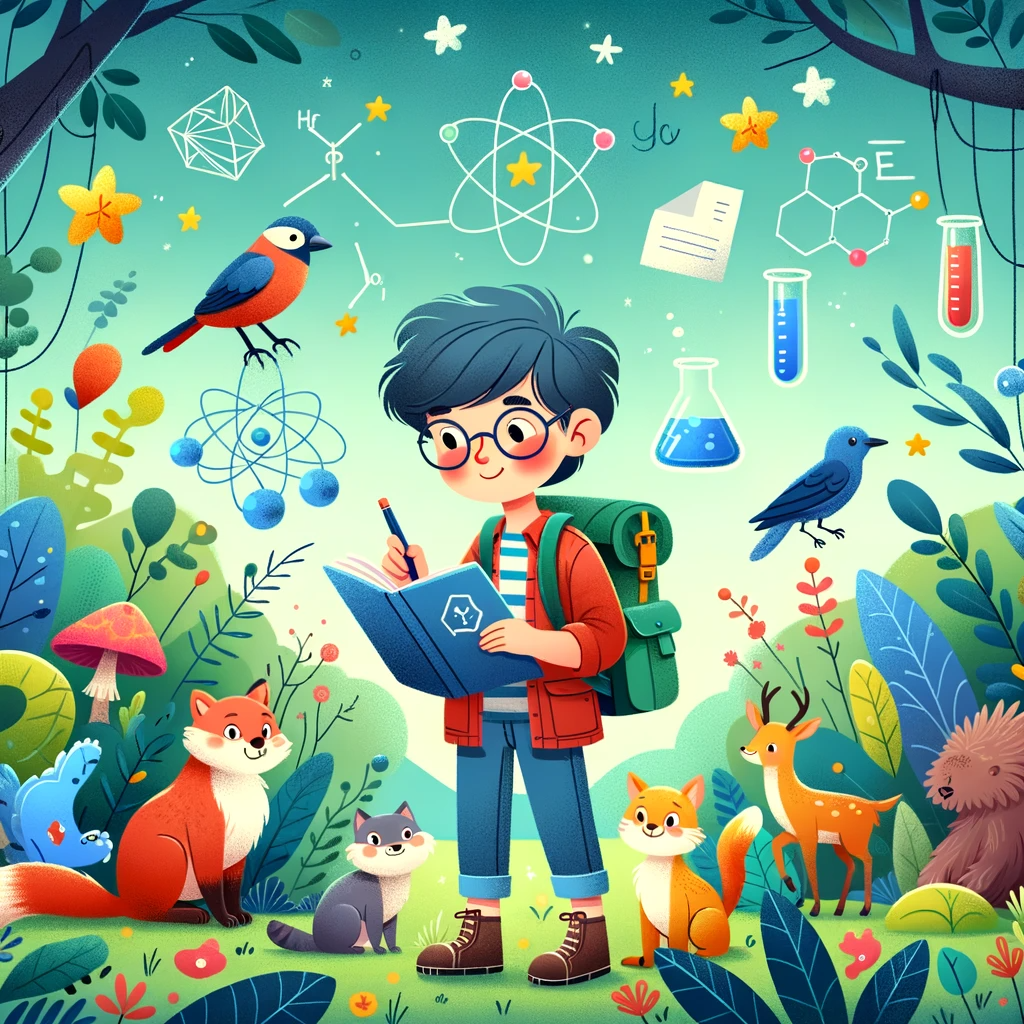
What You Need: A notebook and a pencil.
What to Do: For one day, be a 'Science Detective.' Write down all the things you see, hear, or do that involve science. Maybe it's the sound of birds chirping (Biology) or a rainbow in the sky after rain (Physics). At the end of the day, read your notes and see how science is everywhere!
Our world is full of wonders, and science is the key to unlocking those mysteries. As we journey through this book, you'll discover amazing facts, conduct experiments, and see the world with new eyes. So, put on your explorer hat, grab your magnifying glass, and let's dive into the magic world of science!
Chapter 2: The Tiny Building Blocks: Atoms and Molecules
Hey, future scientist! 🚀
Did you know that everything around you – from the air you breathe to the chair you're sitting on – is made up of tiny, tiny building blocks called atoms? These atoms are so small that even if you took a million of them and lined them up, they might just be as thick as a strand of your hair!
What are Atoms?
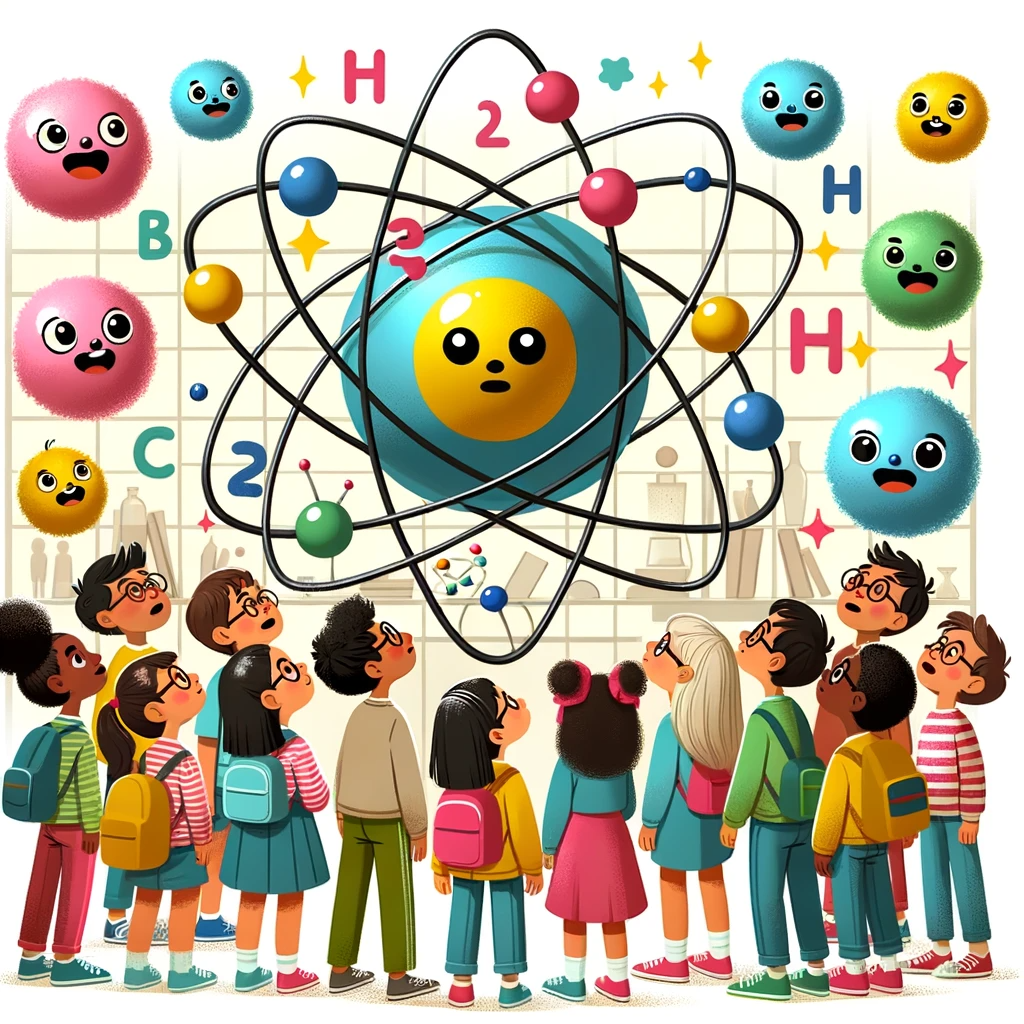
Atoms are the smallest units of matter. Think of them as tiny dots that come together to make up everything. If you zoomed into your favorite toy or a piece of chocolate using a super-duper microscope, you'd see these atoms buzzing around.
Each atom is made up of even tinier parts:
Protons: Positive little guys.
Neutrons: Neutral buddies that don't take sides.
Electrons: Negative ones that spin around the center.
Coming Together: Hello, Molecules!
When atoms come together, they form molecules. It's like when you join different Lego blocks to create a toy. For example, two hydrogen atoms and one oxygen atom come together to make water. That's why water is often called H2O!
Why Should We Care About Atoms and Molecules?
You might wonder, "Why are these tiny things so important?" Well, by understanding atoms and molecules, scientists can create new materials, make medicines, and even find ways to clean our environment.
Activity: Dancing Raisins!
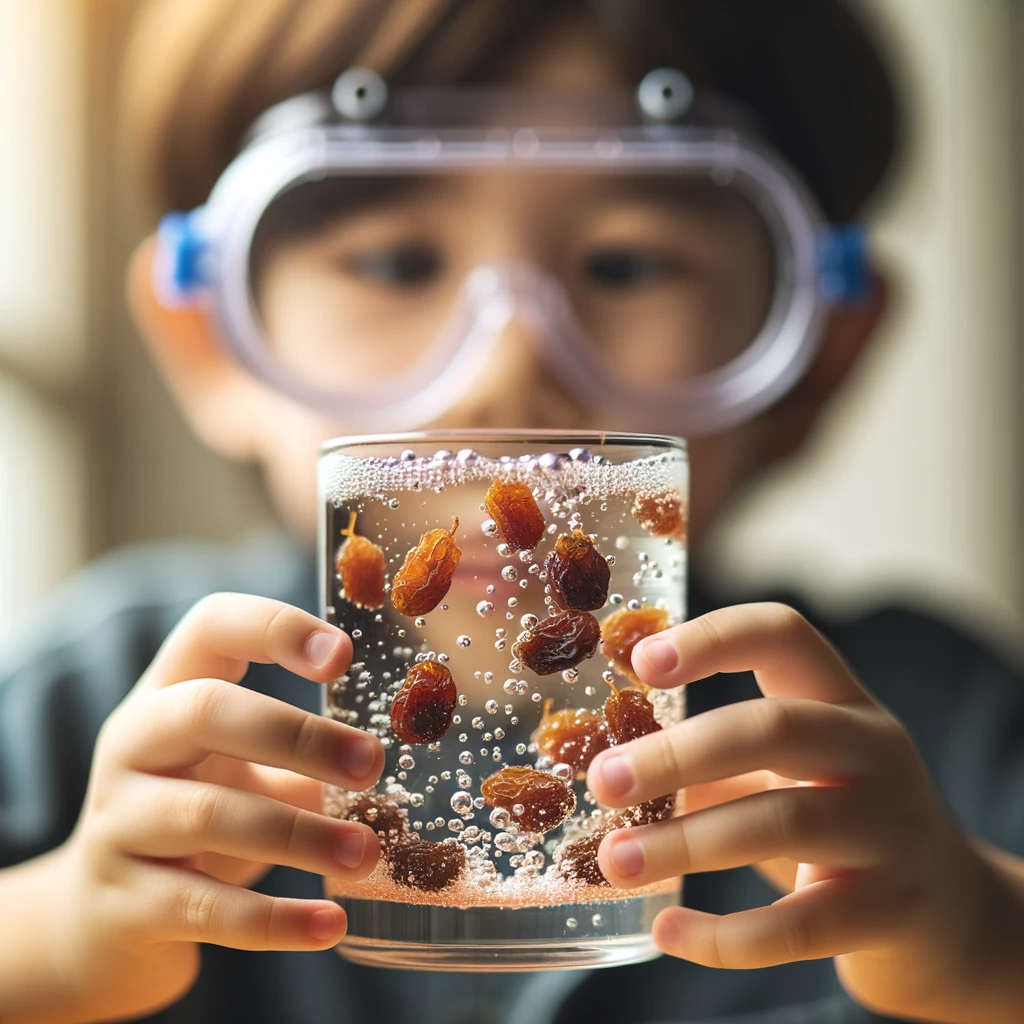
What You Need: A clear glass, soda (like Sprite or 7-Up), and a few raisins. What to Do:
Fill the glass with soda.
Drop a few raisins into the glass.
Watch closely! You'll see the raisins start to dance up and down.
What's Happening? The soda has tiny gas molecules called carbon dioxide. These molecules stick to the raisins, making them float to the top. Once they reach the top, the gas bubbles pop, and the raisins sink again. It's a dance party in a glass!
Atoms and molecules are the magical dots that make up our world. Even though we can't see them with our eyes, they're always working behind the scenes, creating the world around us. Next time you take a sip of water or play with your toys, remember the tiny building blocks that make them!
Chapter 3: The Wonders of Plant Life: Photosynthesis and Growth
Hello again, budding botanist! 🌱
Have you ever wondered how plants eat? Unlike us, they don't have mouths, and you definitely won't find them munching on a sandwich. Instead, they have a super cool process called photosynthesis to make their food. Let's dive into this green wonder!
The Magic of Photosynthesis
Plants have a special ingredient called chlorophyll, which gives them their green color. With the help of sunlight, chlorophyll allows plants to turn carbon dioxide from the air and water from the ground into glucose, a type of sugar. This glucose is their food!
Here's a simple way to remember it: Sunlight + Carbon Dioxide + Water = Glucose (Yummy Plant Food!)
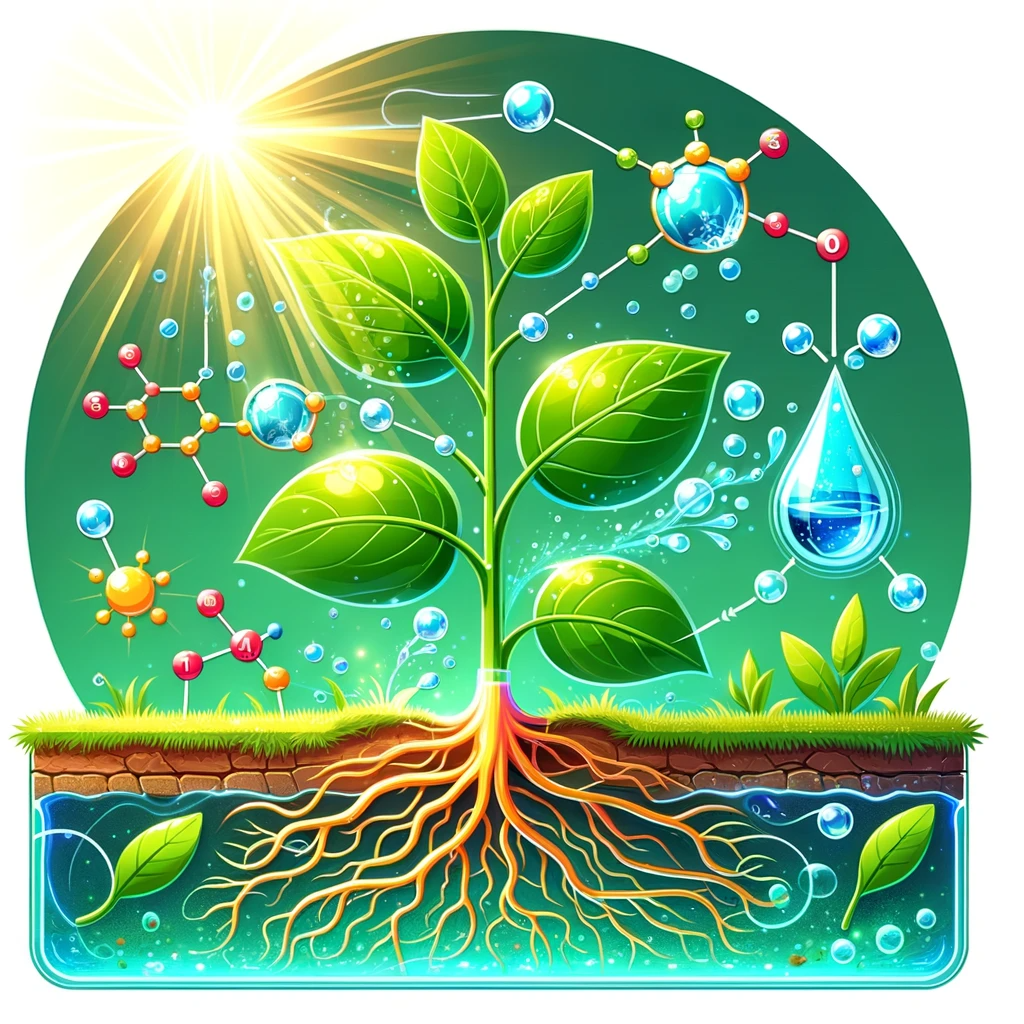
Roots, Stems, and Leaves
Every part of a plant has a unique job:
Roots: They act like straws, sucking up water and nutrients from the soil.
Stems: They're like highways, carrying water and food to different parts of the plant.
Leaves: This is where the magic of photosynthesis happens!
Activity: See the Food-Making in Action!
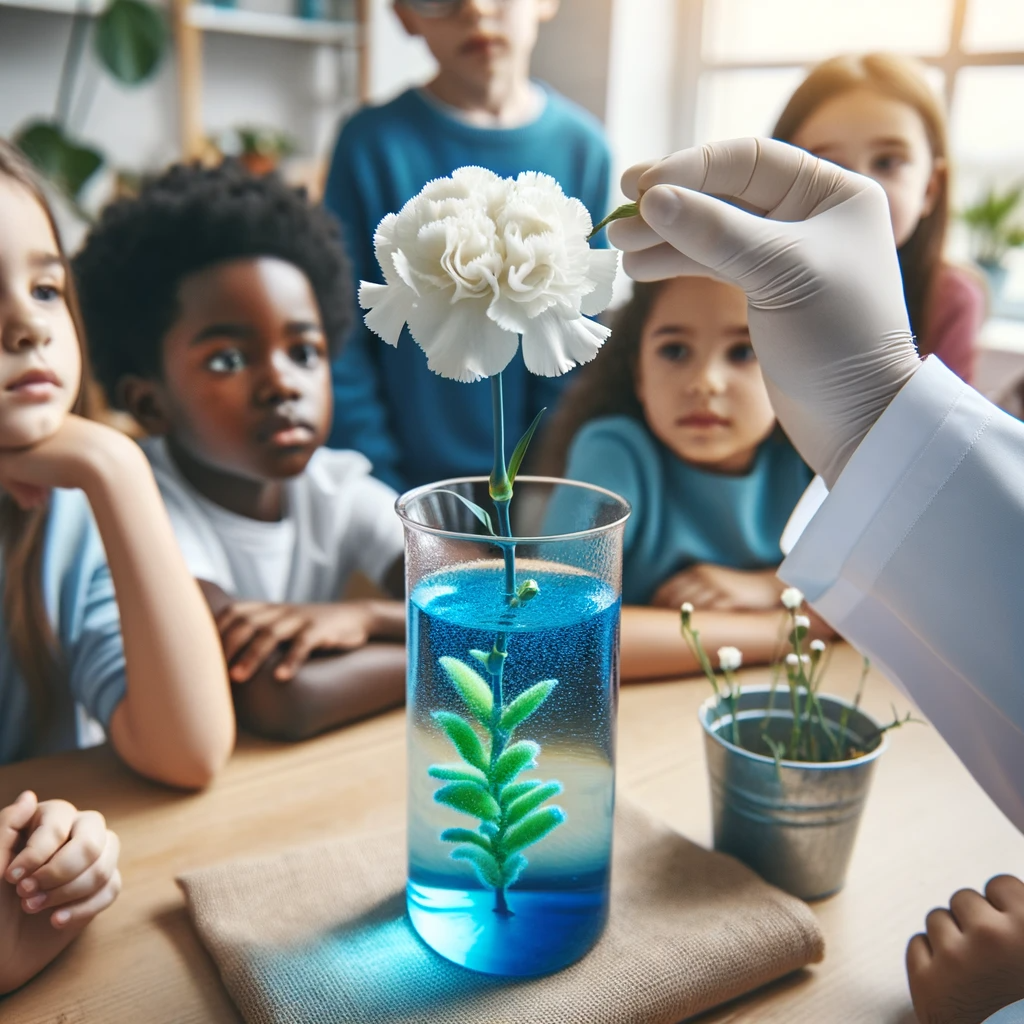
What You Need: A white flower (like a carnation), a vase, and some food coloring. What to Do:
Fill the vase with water and add a few drops of food coloring.
Place the white flower in the vase.
Wait for a day or two and observe the flower.
What's Happening? The colored water travels up the stem and into the petals of the flower, showing how plants "drink" and transport water.
Plants are truly amazing. They not only provide us with oxygen to breathe but also show us the wonders of nature every day. From the tallest tree to the tiniest flower, each plant has its unique way of living and growing. So the next time you're outside, take a moment to appreciate the green wonders around you!
Chapter 4: Animal Adventures: From Fluttering Wings to Deep Sea Dives
Hey there, young explorer! 🐾
Our planet is home to millions of incredible animals. From the birds soaring high in the sky to the mysterious creatures of the deep blue sea, every animal has a story to tell. Are you ready to embark on an exciting animal adventure?
Flying High: The Birds of the Sky
Birds are nature's aviators. Have you ever watched a bird and wondered how it flies? It's all thanks to their lightweight bones and strong wings. Birds also have an excellent sense of direction, which helps them migrate thousands of miles without getting lost. Fun Fact: The Arctic tern is known for having the longest migration, flying from the North Pole to the South Pole and back again!

Under the Sea: The Ocean's Mysteries
Beneath the waves lies a world full of wonder. From colorful clownfish to giant whales, the ocean is teeming with life. Did you know that the deep sea is one of the least explored places on Earth? Some creatures there are so unique that scientists are still discovering new species!
Activity: Animal Sounds Game
What You Need: A group of friends and some creativity! What to Do:
One person mimics an animal sound.
Others guess which animal it is.
Take turns and have fun!
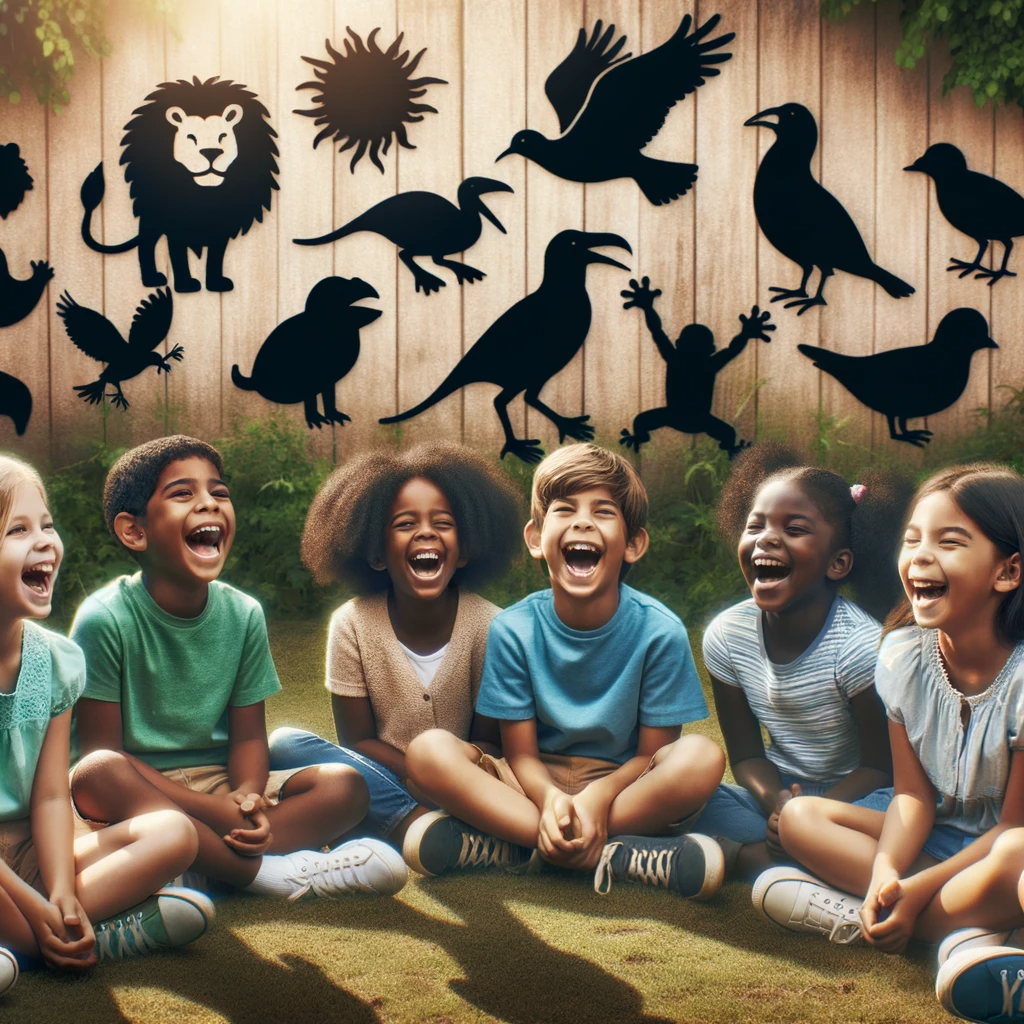
What's Happening? Animals communicate in various ways. This game helps you learn and appreciate the diverse sounds of the animal kingdom.
Animals are fascinating, aren't they? They teach us about adaptability, survival, and the wonders of evolution. Every creature, big or small, plays a vital role in the ecosystem. So, the next time you encounter an animal, remember that you're witnessing a small part of Earth's incredible biodiversity.
Chapter 5: Starry Skies and Galactic Surprises
Hey, future astronaut! 🚀
The night sky is not just about twinkling stars. It's a vast universe full of mysteries, waiting to be explored. From the moon's craters to distant galaxies, there's so much to learn and discover. Ready for a journey beyond our planet?
Moonlit Mysteries
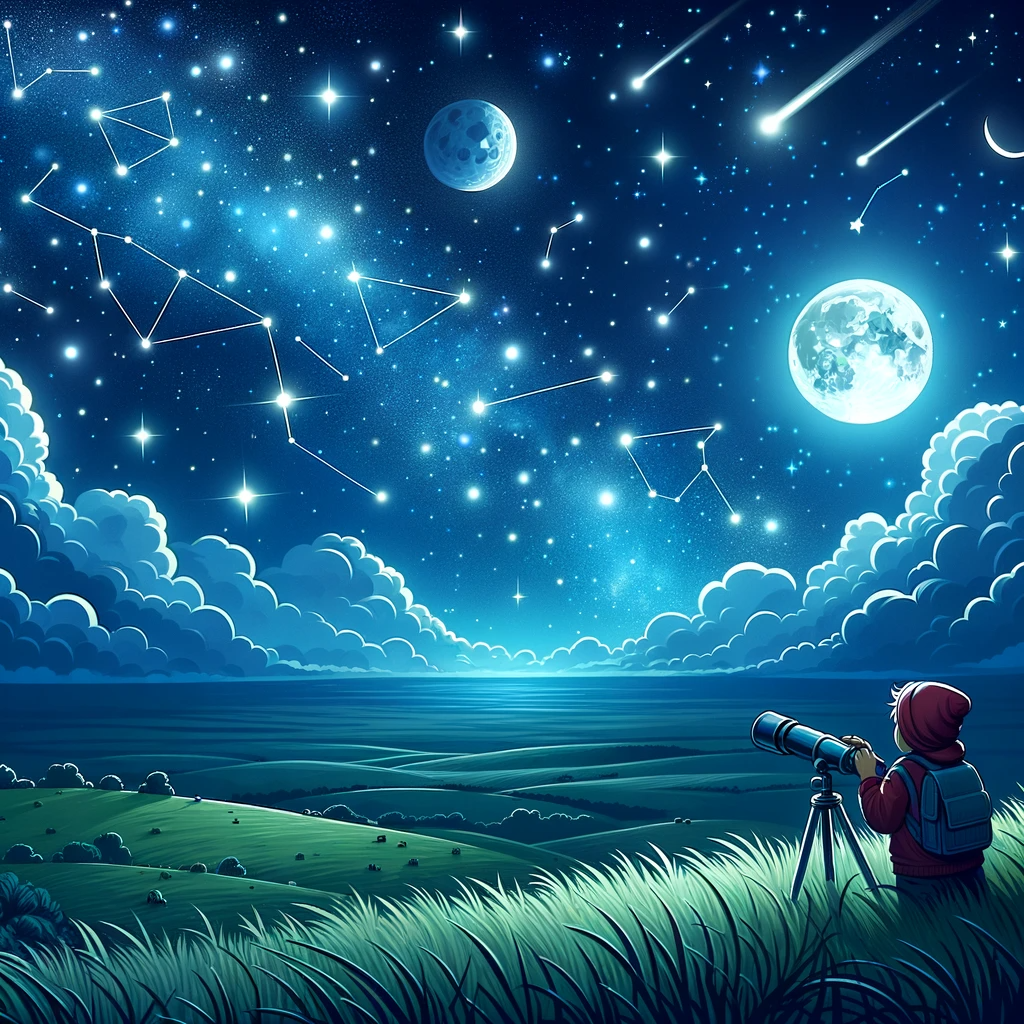
Have you ever looked up at the moon and noticed its different shapes? These phases are due to the moon's position relative to the Earth and the sun. And those spots you see on its surface? They're craters formed by space rocks! Fun Fact: The moon is Earth's only natural satellite and is about 1/6th the size of our planet.
Shooting Stars and Meteor Showers
Shooting stars aren't stars at all! They are meteors burning up as they enter Earth's atmosphere. And when many meteors appear at once? That's a meteor shower, a celestial event that lights up the night sky.
Activity: DIY Constellation Viewer
What You Need: A paper cup, a flashlight, and a small pin. What to Do:
Punch small holes in the bottom of the cup in the shape of your favorite constellation.
Place the flashlight inside the cup, facing the holes.
In a dark room, turn on the flashlight and watch your constellation light up!
What's Happening? Constellations are patterns of stars in the sky. This activity lets you create and view your very own constellation.
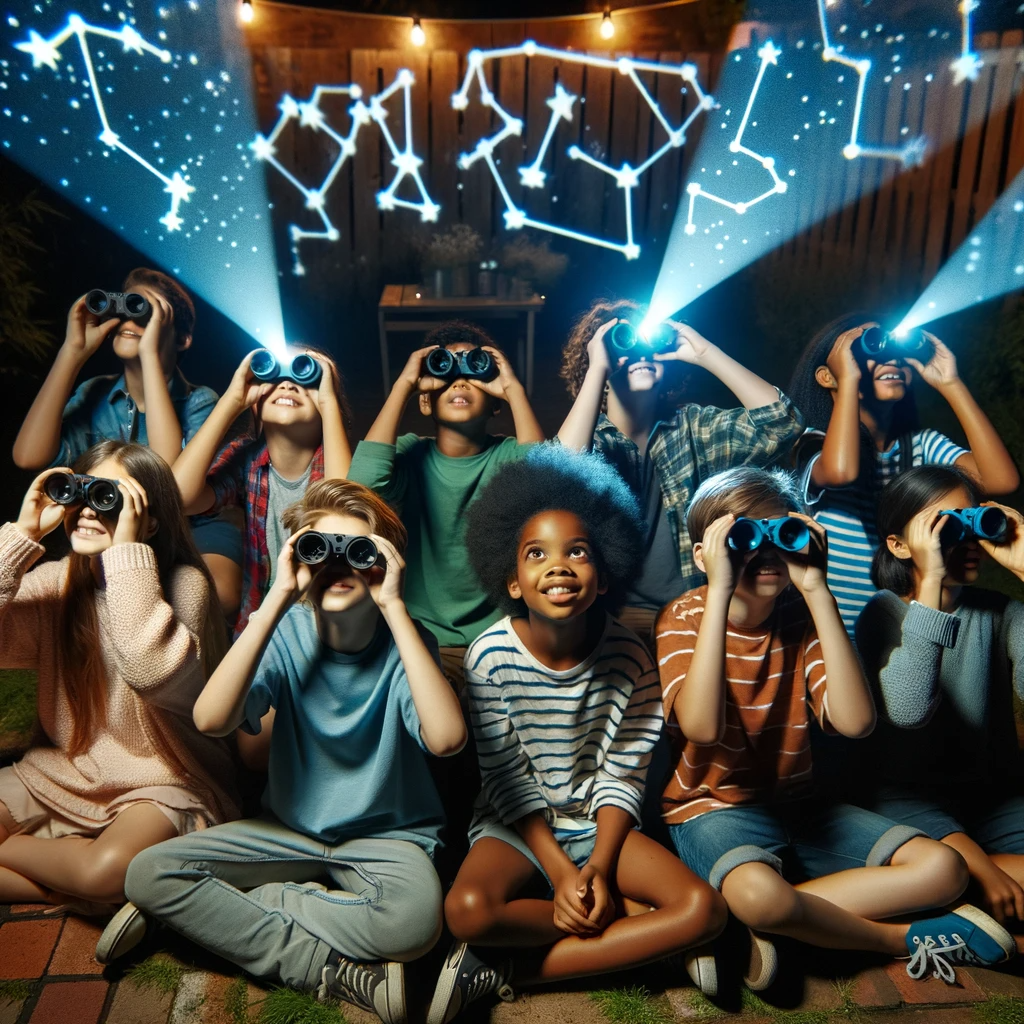
Beyond Our Solar System
Our solar system is just a tiny part of the vast Milky Way galaxy. Beyond it lie billions of galaxies, each with millions of stars, planets, and other celestial wonders. The universe is vast, ever-expanding, and full of unimaginable beauty.
The universe is a vast and wondrous place, offering endless opportunities for exploration and discovery. As you gaze up at the night sky, remember that you're looking at the history of our universe, with light from distant stars that began its journey millions of years ago.
Chapter 6: The Green Guardians of Earth
Hello, budding botanists! 🌱
Our planet is home to an astounding variety of plants, from towering trees to delicate flowers. These green guardians not only beautify our world but also play a vital role in maintaining life on Earth. Let's embark on a botanical journey and uncover the secrets of the plant kingdom.
The Breath of Life
Plants do something magical every day – they convert sunlight into food through a process called photosynthesis. And guess what? While making their food, they release oxygen, which we breathe in! It's like plants are Earth's natural air purifiers. Fun Fact: Trees, especially in rainforests, produce 20% of the oxygen we breathe.
The Colorful World of Flowers
Flowers aren't just pretty to look at; they have a purpose. They attract pollinators like bees, butterflies, and birds with their vibrant colors and sweet nectar. This helps in the process of pollination, which leads to the creation of new seeds and the birth of new plants.
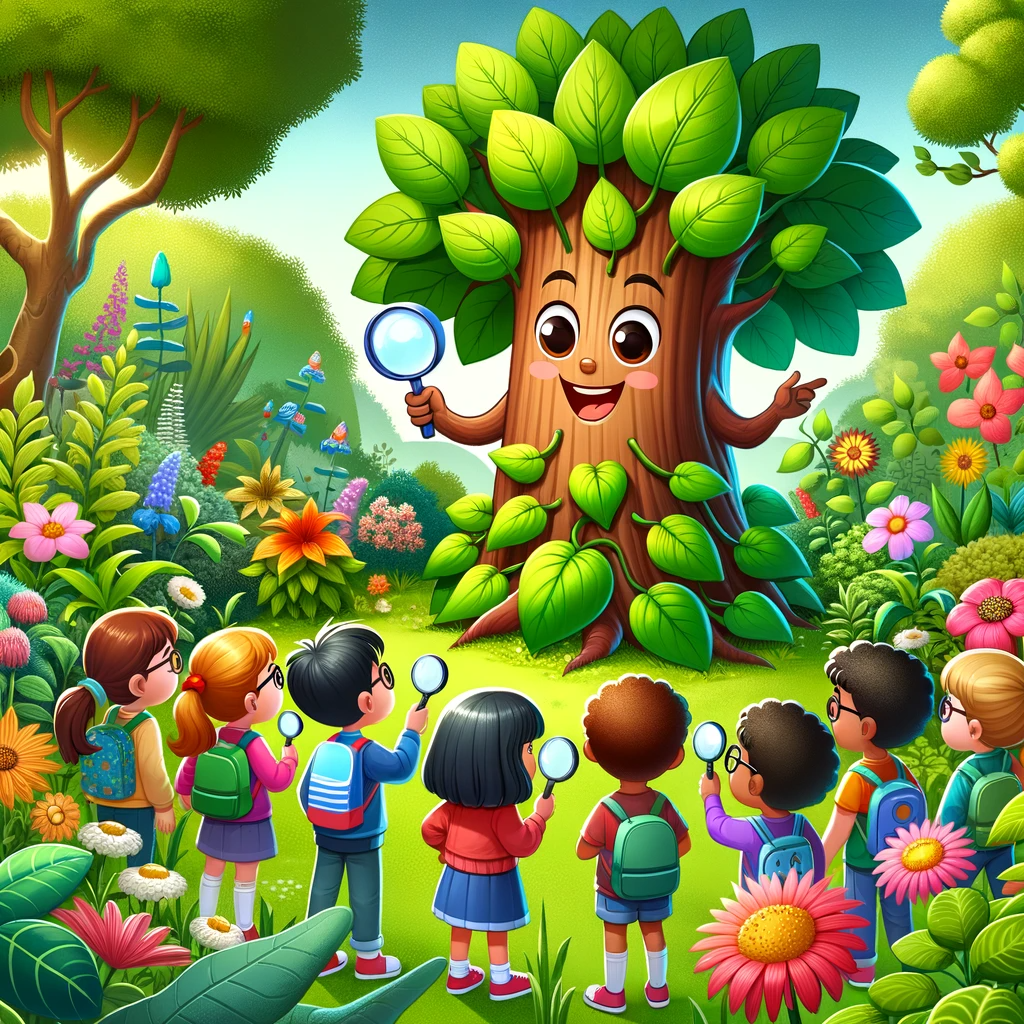
Activity: Leaf Rubbing Art
What You Need: A leaf, a white paper, crayons. What to Do:
Place the leaf under the paper.
Gently rub the crayon over the paper where the leaf is.
Marvel at the beautiful imprint of the leaf's veins and patterns!
What's Happening? This activity showcases the intricate patterns and designs found in nature, especially on leaves.
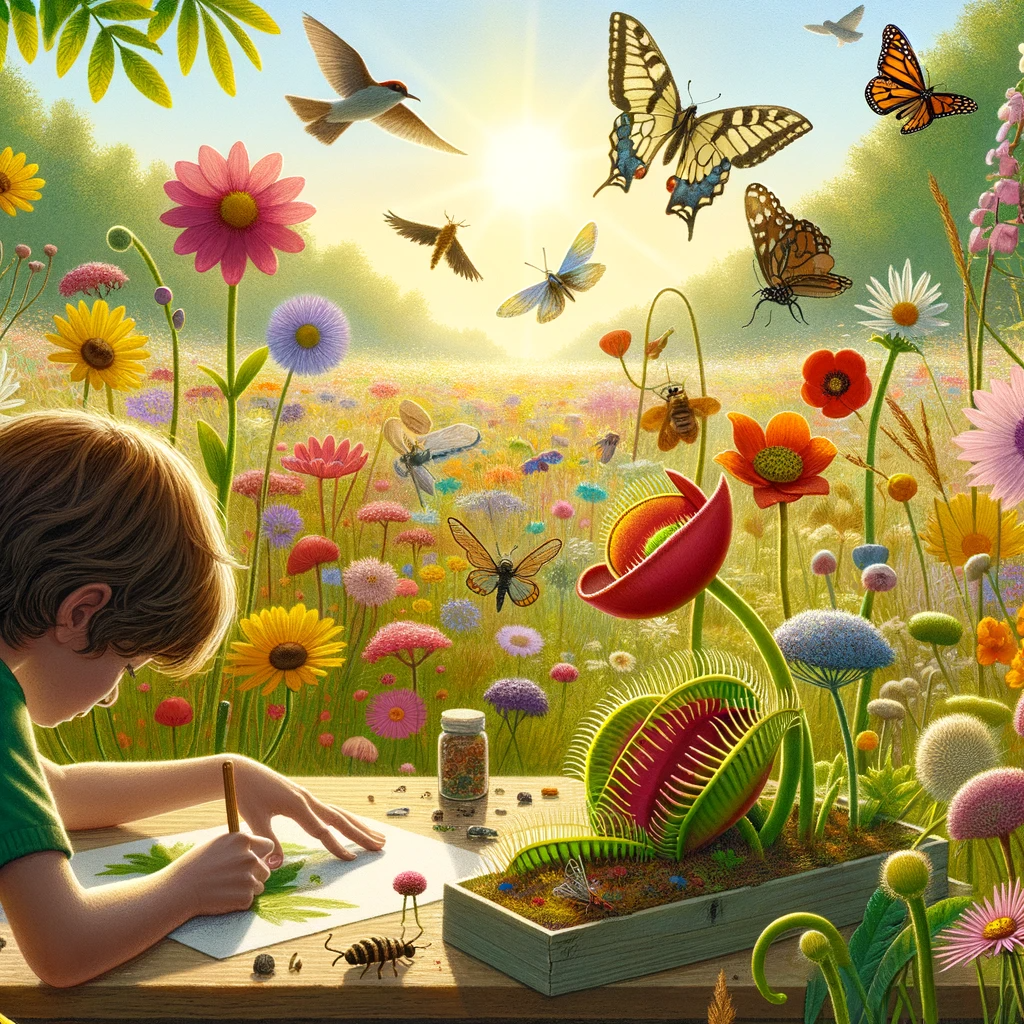
Plants with Superpowers
Not all plants are as docile as they seem. Some have superpowers! Venus flytraps catch insects, while sunflowers can turn their heads to follow the sun. Some plants even have medicinal properties that can heal.
Plants are the unsung heroes of our planet. They provide us with food, oxygen, and medicine. They're also home to countless creatures. So, the next time you see a plant, take a moment to appreciate its beauty and significance.
Chapter 7: The Wonders of Water
Hello, young aquanauts! 💧
Water is everywhere, from the vast oceans that cover our planet to the tiny droplets of dew on a leaf. It's essential for all life and has some amazing properties that make it unique. Join us on this splashy adventure as we explore the wonders of water.
The Cycle of Life
Water is always on the move. It evaporates from oceans, forms clouds, falls as rain, and travels through rivers back to the sea. This never-ending journey is known as the water cycle. Fun Fact: Did you know that the water you drink today could have been part of a cloud or even a snowflake in the past?
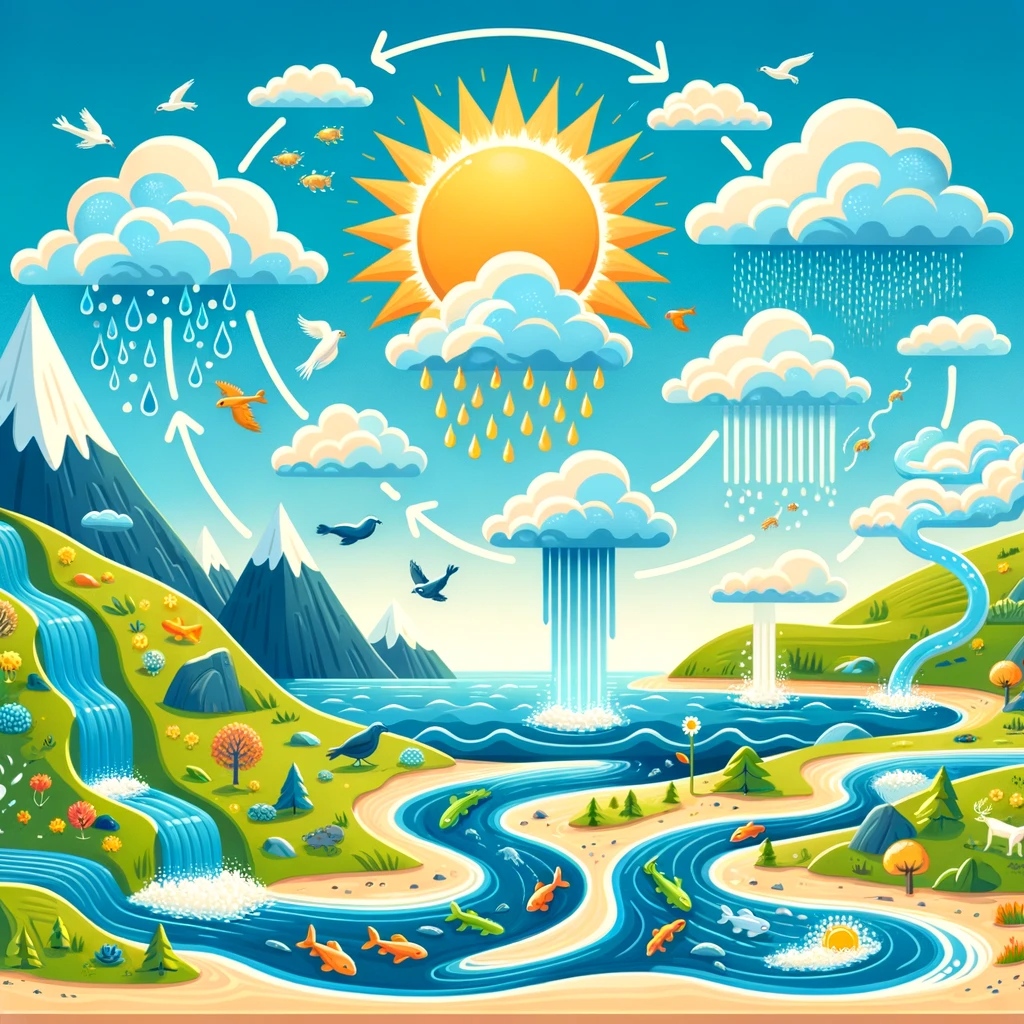
Floating and Sinking
Objects in water either float or sink. But why? It's all about density. If something is denser than water, it sinks. If it's less dense, it floats. This is why heavy ships made of metal can float on water.
Activity: The Floating Egg Experiment
What You Need: An egg, a glass of water, salt. What to Do:
Place the egg in the glass of water. What happens?
Now, add 3 tablespoons of salt and stir until dissolved. Place the egg again. What do you observe?
What's Happening? Salt increases the water's density, making the egg float!
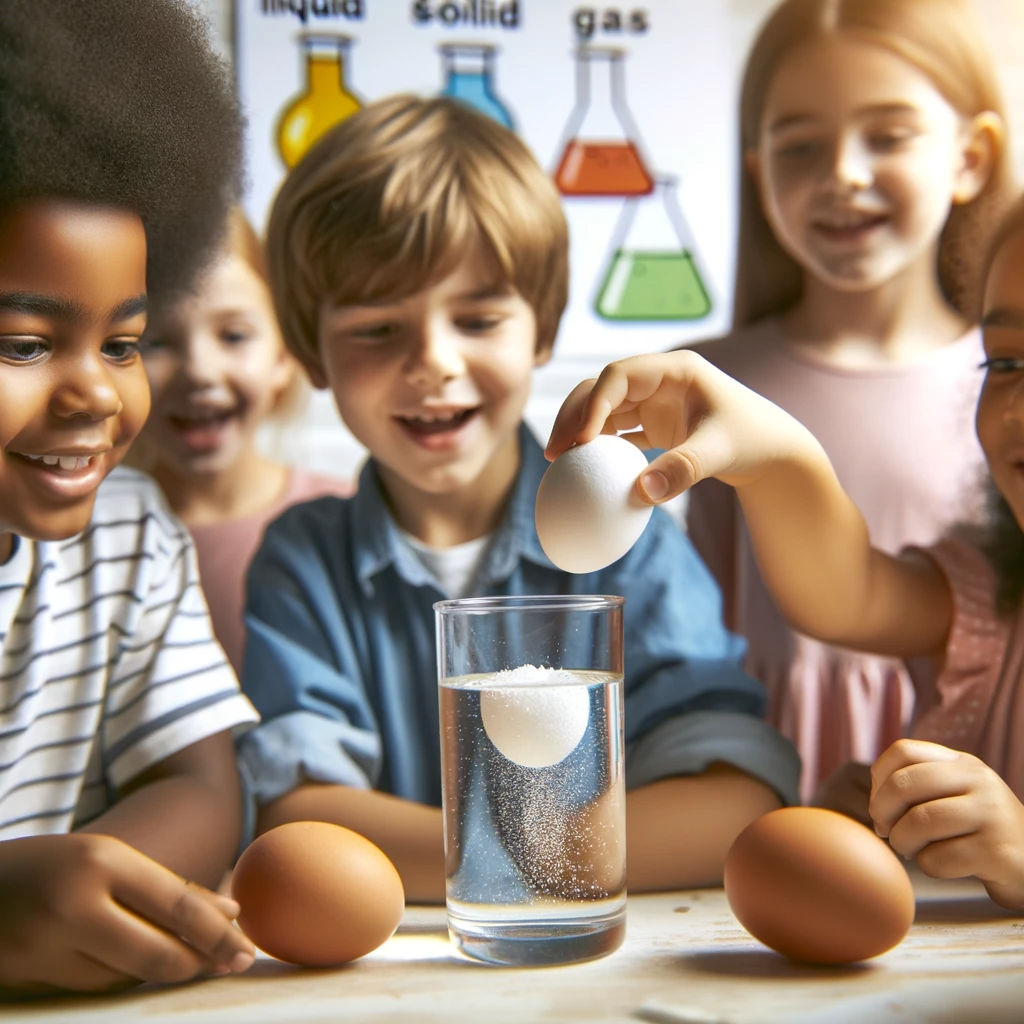
Water's Amazing Abilities
Water can be a liquid, solid (ice), or gas (steam). It also has a unique property called surface tension, allowing small insects to "walk" on water.
Protecting Our Blue Planet
Water is precious, and we need to protect it. Pollution and wastage can harm our water sources. Always remember to use water wisely and keep our rivers, lakes, and oceans clean.
Water is truly wonderful. It quenches our thirst, is home to countless marine creatures, and shapes our planet in many ways. So, the next time you take a sip of water, remember the incredible journey it has been on!
Chapter 8: Colors of the Rainbow: Understanding Light and Color
🌈✨
Have you ever looked up at the sky after a rainstorm and marveled at the beautiful arc of colors? That's a rainbow! But what makes these brilliant colors appear? Let's dive into the magical world of light and color to find out
What is Light?
Before we talk about colors, we need to understand what light is. Light is a form of energy that our eyes can see. It travels in waves, just like the waves in the ocean. But not all light waves are the same. Some are long, and some are short, which brings us to the colors of the rainbow.
The Spectrum of Colors
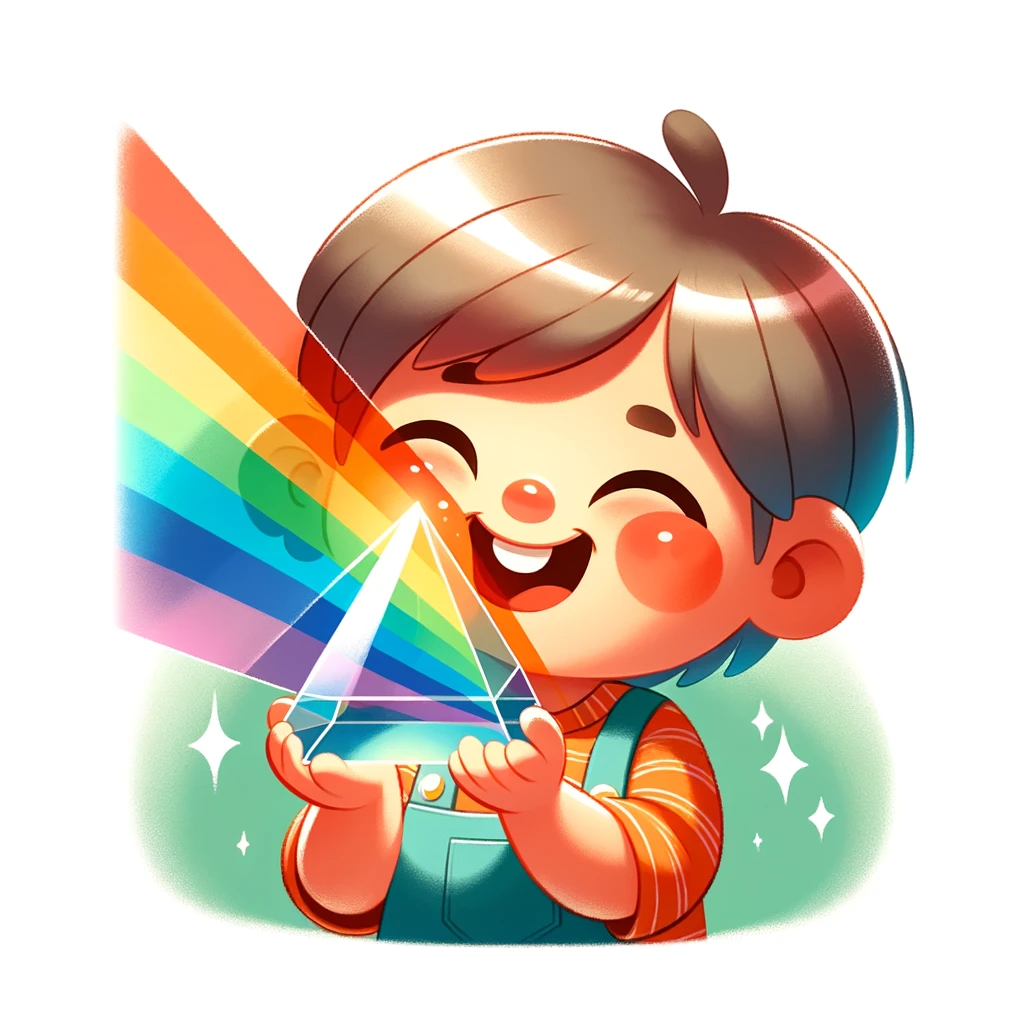
When light passes through a glass prism or even droplets of water (like after a rainstorm), it bends and splits into different colors. This is called refraction. The reason we see different colors is that each color has a different wavelength. Red has the longest wavelength, and violet has the shortest.
Remember the order of the colors with this fun phrase: Red, Orange, Yellow, Green, Blue, Indigo, and Violet. ROYGBIV!
Why is the Sky Blue?
Have you ever wondered why the sky is blue during the day? It's all thanks to the short wavelengths of blue and violet light. Our atmosphere scatters these short wavelengths more than the others, making the sky appear blue to our eyes.
Mixing Colors
Colors are fun to mix! When you combine two primary colors (red, blue, and yellow), you get secondary colors. For instance:
Red + Yellow = Orange
Yellow + Blue = Green
Blue + Red = Purple
Experiment with mixing colors, and you'll see a whole new world of shades and hues!
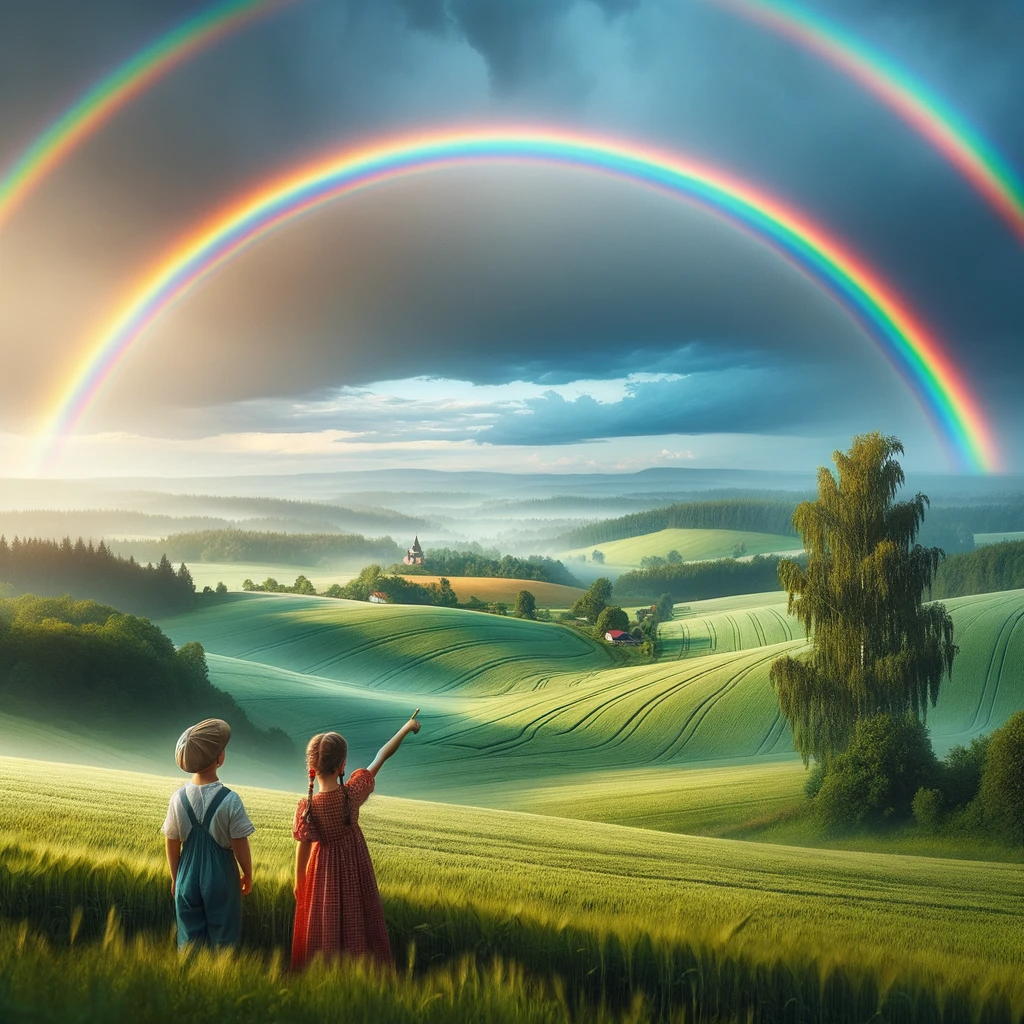
The Magic of White Light
Here's a fun fact: when you mix all the colors of the rainbow, you get white light! It might seem surprising, but it's true. Objects appear colored because they reflect some colors and absorb others. A white shirt looks white because it reflects all the colors, while a black shirt absorbs them.
Colors are all around us, from the clothes we wear to the beautiful scenes in nature. By understanding light and how it interacts with objects, we can appreciate the vibrant world around us even more. So, the next time you see a rainbow, remember the wonderful science behind those dazzling colors.
🌈 Keep exploring and enjoying the colors of our world! 🎨
Chapter 9: The Mysterious World Beneath
Ahoy, young explorers! 🌊
The vast oceans cover over 70% of our planet, yet much of it remains a mystery. From colorful coral reefs to deep-sea vents, the oceans are teeming with life and wonder. Let's embark on a voyage to uncover some of the ocean's most fascinating secrets.
Coral Reefs: Rainforests of the Sea
Coral reefs are vibrant ecosystems that provide a home for thousands of marine species. Fish of all colors, shapes, and sizes dart between the corals, while sea anemones wave their tentacles in the gentle currents. Fun Fact: Did you know that corals are actually animals, not plants?
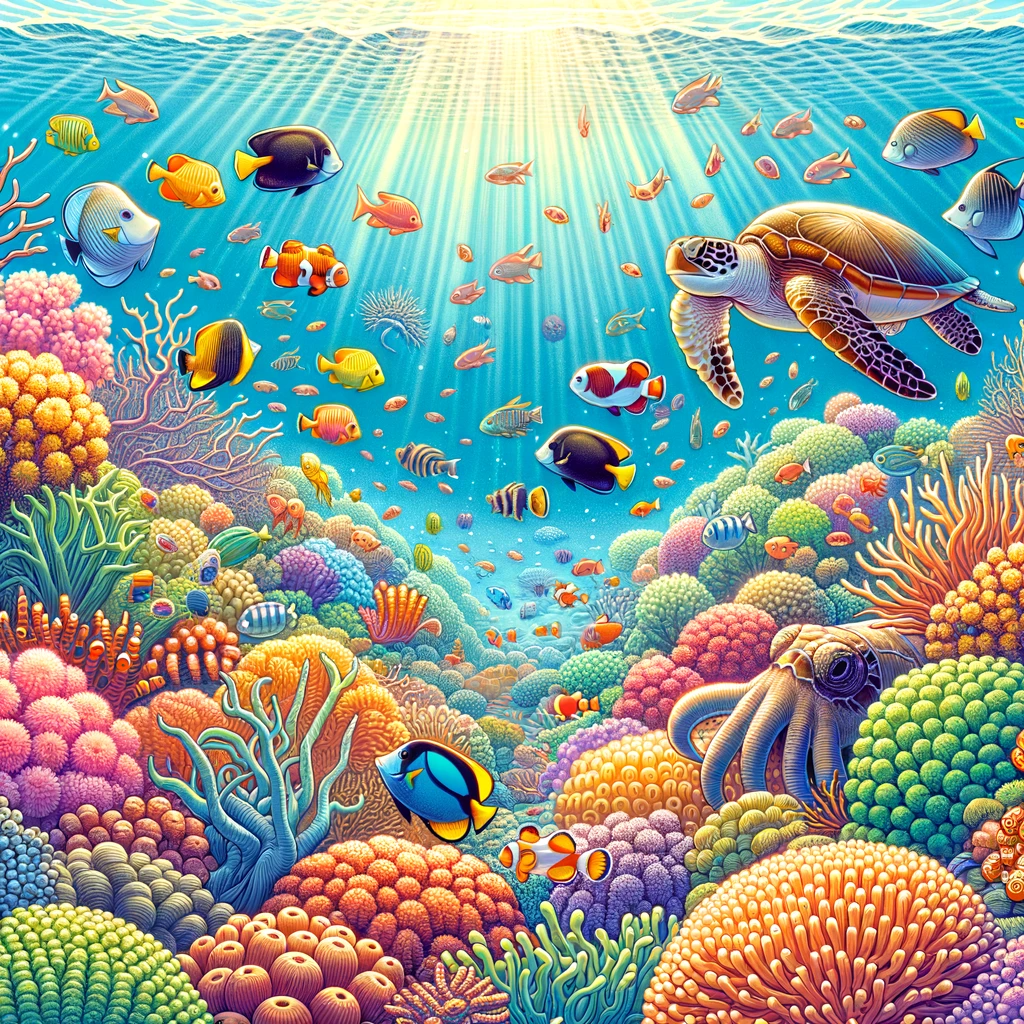
Majestic Marine Mammals
Whales, dolphins, and seals are just a few of the incredible mammals that call the oceans their home. They breathe air, just like us, and have unique ways of communicating with each other.
Activity: Whale Song Listening Session
What You Need: A device with internet access. What to Do:
Search online for recordings of whale songs.
Listen and try to identify the different sounds and patterns.
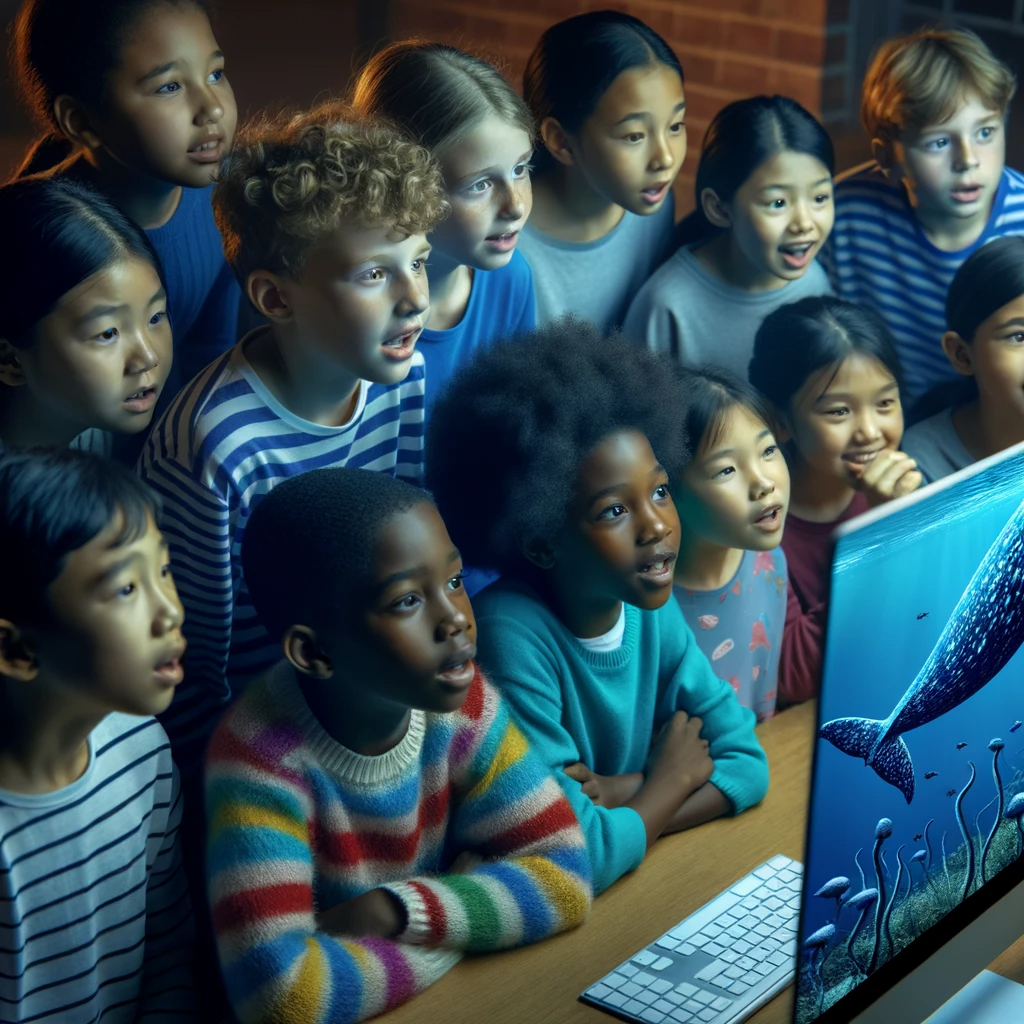
Deep-Sea Mysteries
The deepest parts of the ocean are dark and mysterious. Creatures like the anglerfish, with its glowing lure, and the giant squid live in these extreme depths.
The Importance of Conservation
Our oceans are facing threats from pollution, overfishing, and climate change. It's essential for us to take care of them, not only for the marine life but for our own survival as well.
The oceans are vast, beautiful, and full of mysteries waiting to be discovered. As we continue to explore and learn, let's also remember to protect and cherish these incredible underwater worlds.
Chapter 10: Beyond the Blue - The Wonders of Space
Greetings, space cadets! 🌌
Gazing up at the night sky, have you ever wondered what lies beyond those twinkling stars? The universe is vast, filled with wonders that have captured human imagination for centuries. Let's blast off on a journey to explore the cosmic wonders that await us!
Our Sun: The Star of the Show
Did you know our Sun is a star? It might look different because it's much closer to us than any other star. It provides us with warmth, light, and is essential for life on Earth. Fun Fact: The Sun is so large that over a million Earths could fit inside it!
The Moon: Earth's Celestial Companion
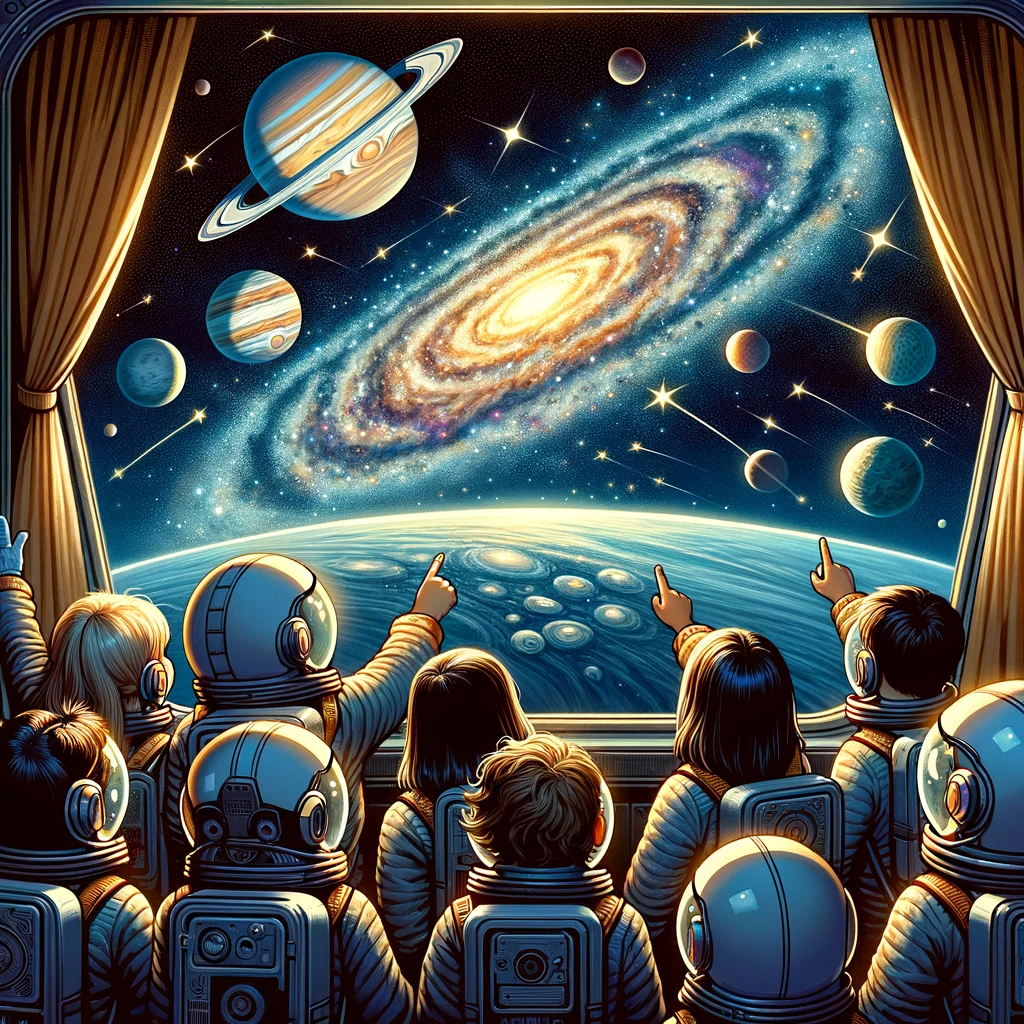
We've all seen the Moon light up the night, but there's so much more to it. Its surface has mountains, valleys, and large, round pits called craters.
Activity: Moon Phase Journal
What You Need: A notebook and a pencil.
What to Do:
Every night for a month, look at the Moon and draw its shape in your notebook.
At the end of the month, see if you can spot the pattern of how the Moon changes!
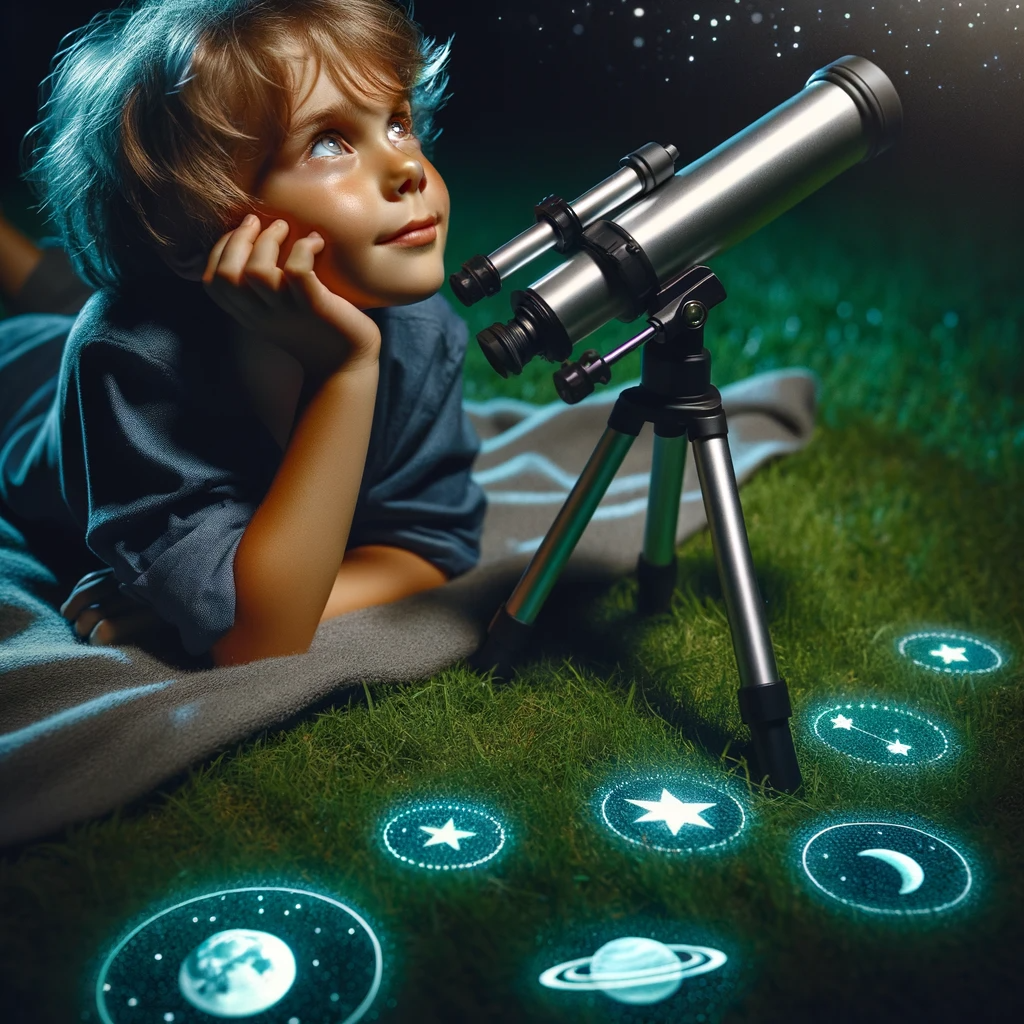
Planets, Asteroids, and Comets
Beyond our Moon, there are other fascinating objects in our solar system. The giant Jupiter, ringed Saturn, and the red Mars are just a few of the planets. Don't forget about the asteroids and comets zooming around!
The Milky Way and Beyond
Our solar system is just a tiny part of a vast galaxy called the Milky Way. And guess what? There are billions of other galaxies out there!
The universe is vast, mysterious, and filled with wonders beyond our imagination. As we continue to gaze at the stars and explore the cosmos, we learn more about our place in this grand cosmic dance.
Chapter 11: The Tick-Tock of Time - Understanding Moments and Millennia
Hey, time travelers! ⏳
Have you ever wondered why a minute has 60 seconds or why a day has 24 hours? Or how about why we celebrate birthdays once a year? Time is a fascinating concept, and it shapes our daily lives in many ways. Let's embark on a journey through the ages and unravel the mysteries of time!
Seconds, Minutes, and Hours
Every tick and tock of a clock counts a second. Put 60 of those together, and you have a minute. Stack up 60 minutes, and ta-da, you've got an hour! These measurements help us organize our day, from school to playtime. Fun Fact: The idea of dividing an hour into 60 minutes and a minute into 60 seconds comes from the ancient Sumerians, who loved the number 60!
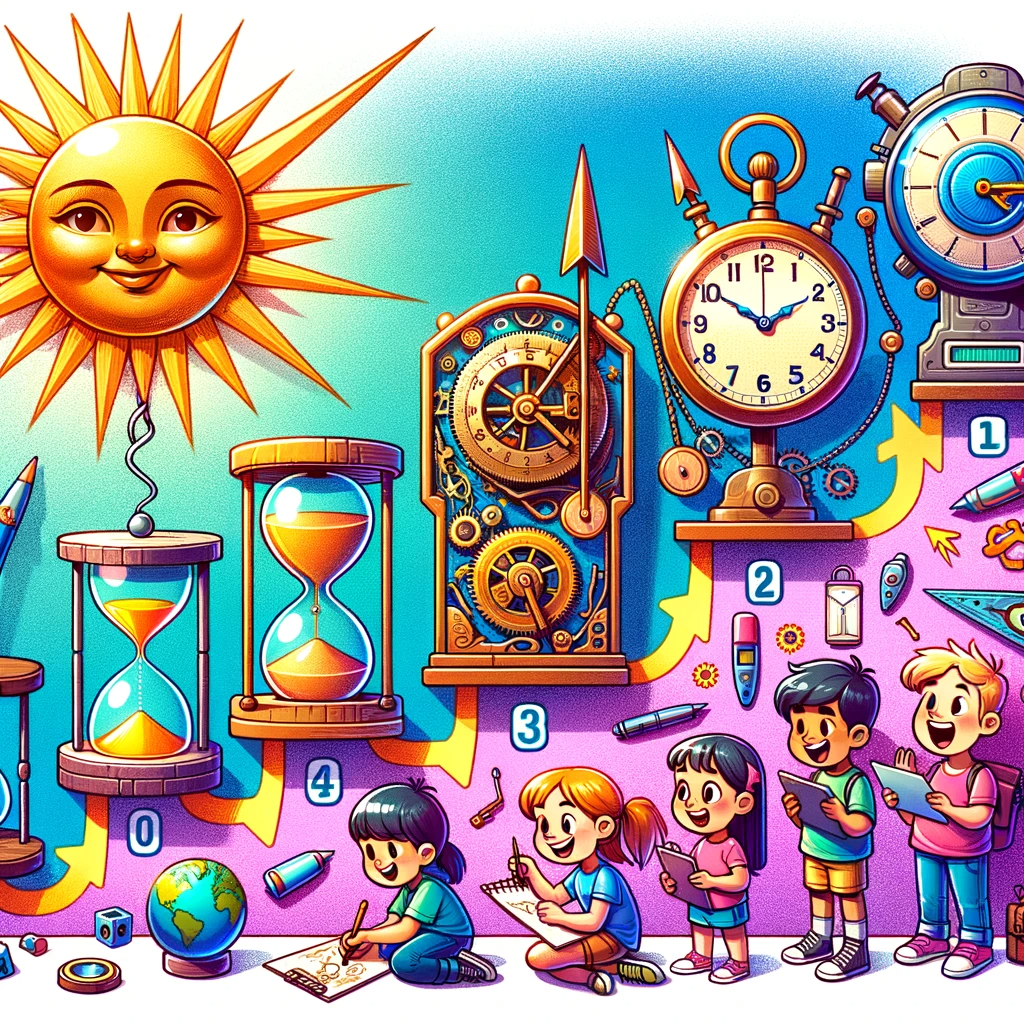
Days, Weeks, Months, and Years
The Earth takes about 24 hours to spin around once. That gives us one day. Put seven of those days together, and you have a week. As the Earth travels around the Sun, we get months and, eventually, a complete year.
Activity: Create Your Own Calendar!
What You Need: Colorful paper, markers, stickers. What to Do:
Draw a grid for a month.
Fill in the days and decorate with stickers for special events.
Hang it up and track your fun activities!
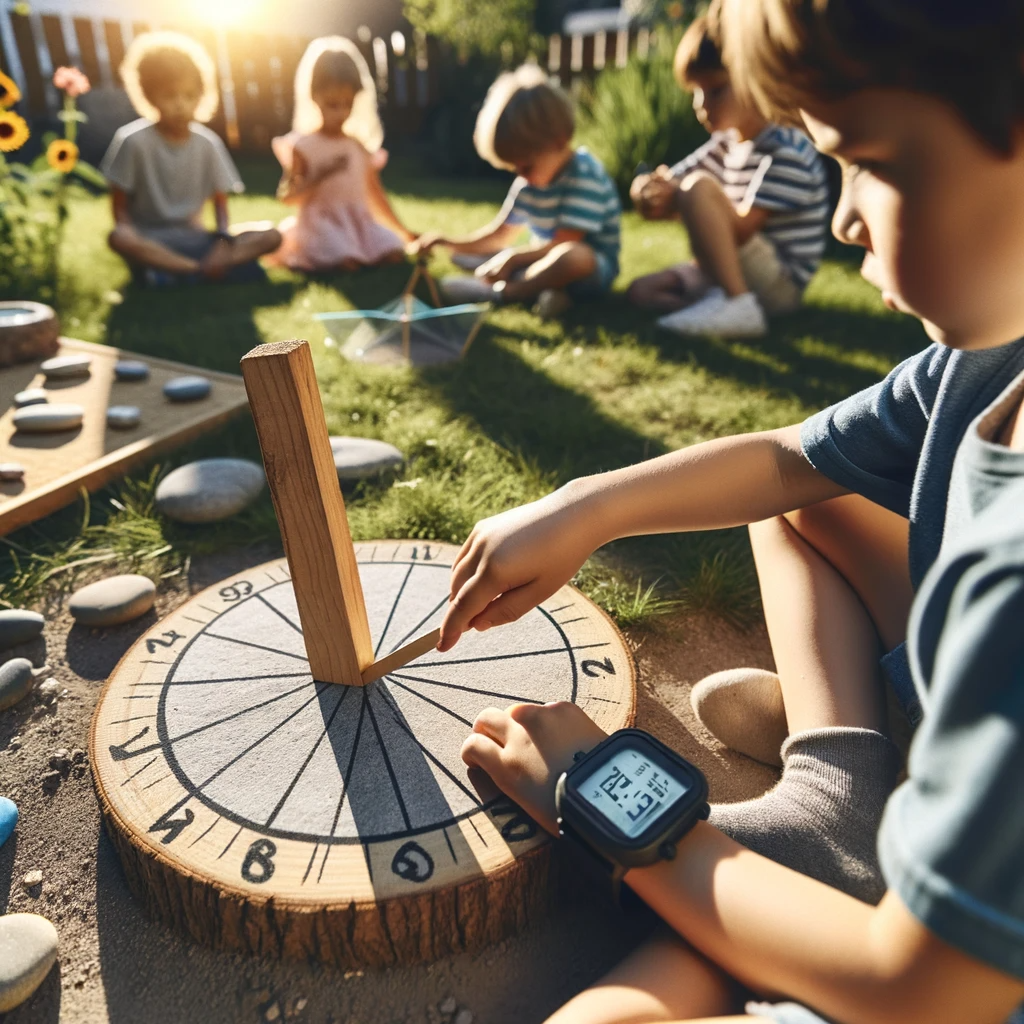
A Leap into Leap Years
Every 4 years, something special happens: February gets an extra day! This is because it actually takes the Earth a little more than 365 days to orbit the Sun.
From Sundials to Digital Clocks
Long before we had clocks on our phones or walls, people used sundials and water clocks to tell time. It's amazing how our ways of measuring time have evolved!
Time might seem like a simple concept, but there's a rich history and science behind it. As we grow up, we'll have more moments, hours, and days to explore, learn, and create memories. So, let's make every second count!
Chapter 12: The Wonders of Gravity - The Invisible Force!
🌍🍎⬇️
Have you ever wondered why things fall when you drop them? Why don't we just float away into the sky? The answer is gravity!
What is Gravity?
Gravity is an invisible force that pulls objects toward each other. The bigger the object, the stronger its gravitational pull. That's why Earth, being much larger than us, pulls us towards it, and we stay grounded.
Sir Isaac Newton and the Falling Apple
Legend has it that Sir Isaac Newton discovered gravity when he saw an apple fall from a tree. He wondered why the apple fell straight down and not sideways or upwards. This led him to formulate the laws of gravity.
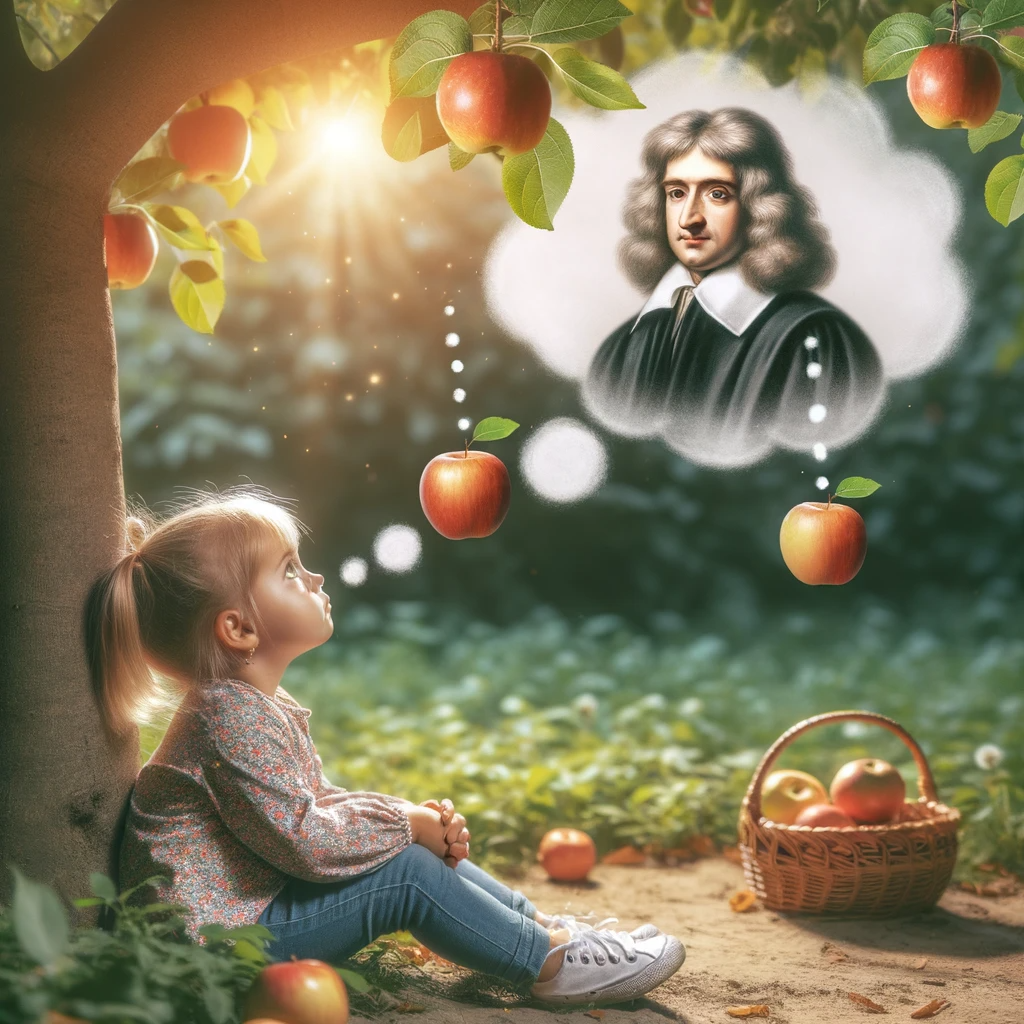
Activity: The Feather and the Hammer
What You Need: A feather, a hammer. What to Do:
Drop the feather and observe how it falls.
Drop the hammer and see the difference.
Why do they fall differently? It's because of air resistance, not gravity! In a vacuum (a place without air), they would fall at the same rate.
Gravity in Space
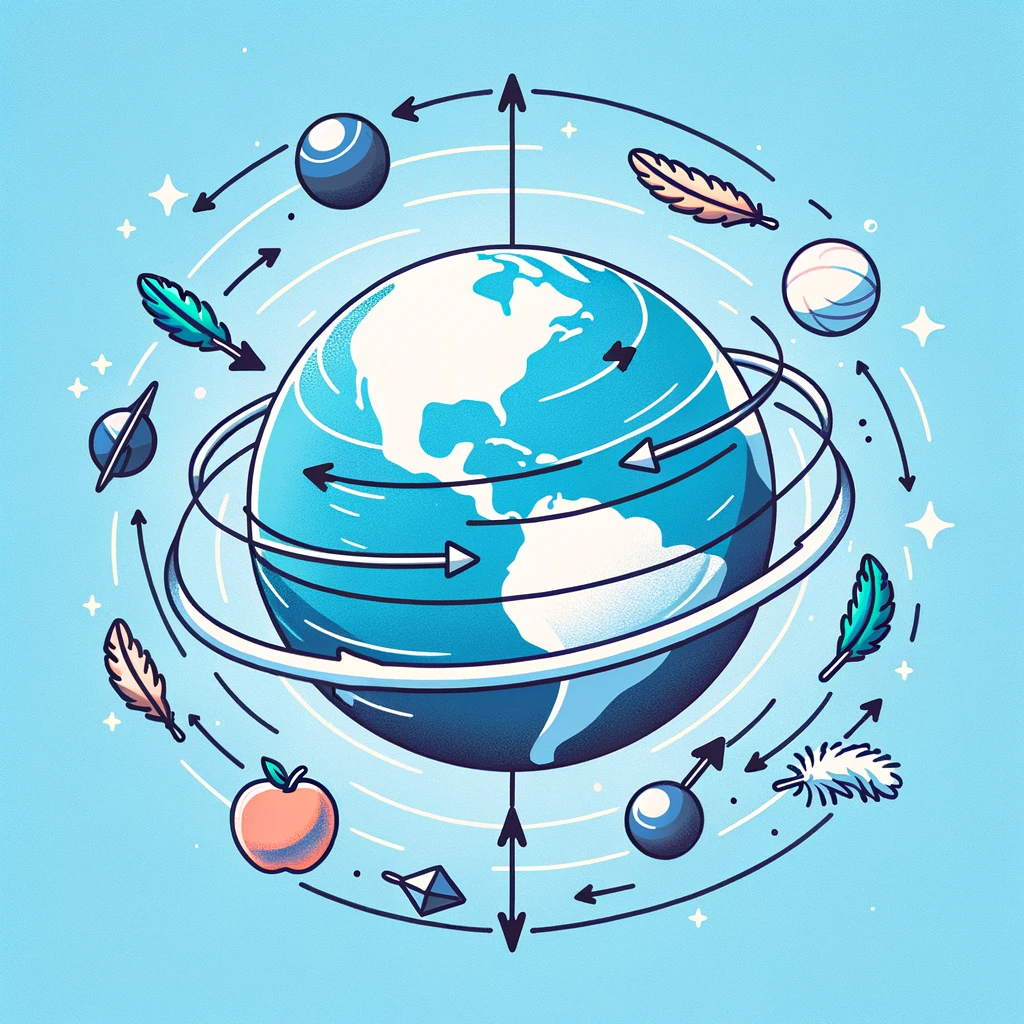
Orbiting Planets: Planets orbit the sun because of gravity. They're constantly falling toward the sun but also moving forward, creating an orbit.
Weightlessness: Astronauts seem like they're floating in space not because there's no gravity, but because they're in continuous free fall around the Earth
Fun Gravity Facts
Jumping on Other Planets: If you were to jump on the moon, you'd jump higher than on Earth because the moon's gravity is weaker.
Tides: Ocean tides are caused by the gravitational forces exerted by the moon and the sun.
Chapter 13: From Tiny Seeds to Tall Trees - The Amazing World of Plants!
🌱🌺🌳
Everywhere you look, from your backyard to the densest forests, plants play a crucial role in our world. They're more than just pretty flowers or leafy trees; plants are nature's miracle workers! Let's embark on a journey to discover the magic of plants.
The Life of a Plant
Seed: Every plant starts as a tiny seed. Inside each seed is a baby plant, waiting for the right conditions to grow.
Sprout: With water, sunlight, and soil, the seed begins to grow roots and shoots
Plant: Over time, the sprout grows taller, develops leaves, and becomes a young plant.
Flowering and Fruiting: Some plants produce beautiful flowers, and later, delicious fruits or vegetables.
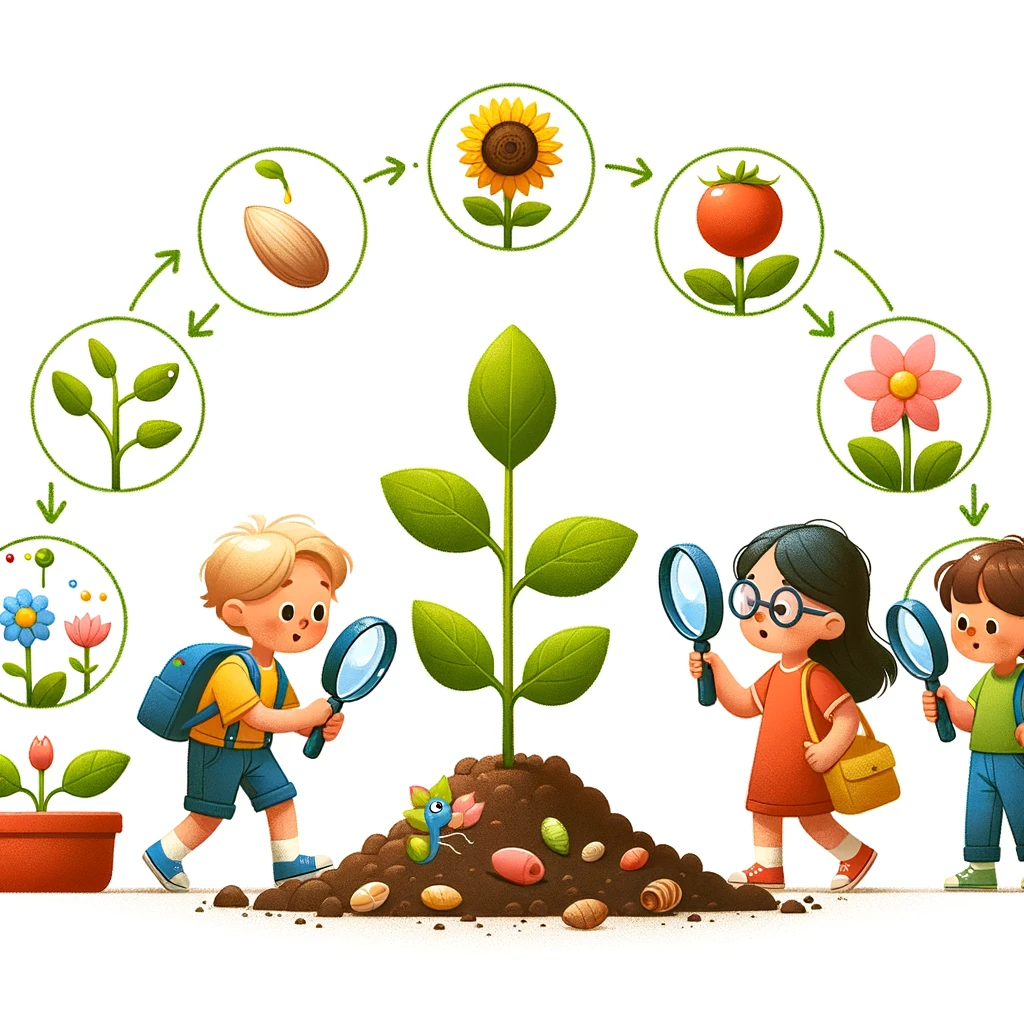
Why Are Plants So Important?
Oxygen Providers: Plants take in carbon dioxide and release oxygen, making the air we breathe!
Food Sources: Fruits, vegetables, grains - so much of our food comes from plants.
Habitats: Forests, jungles, and gardens are homes for countless animals.
Activity: Grow Your Own Bean Plant!
What You Need: A bean seed, a clear plastic cup, soil, and water. What to Do:
Fill the cup with soil.
Place the bean seed about an inch deep.
Water it lightly and place it near a window.
Watch your bean sprout and grow over the weeks!
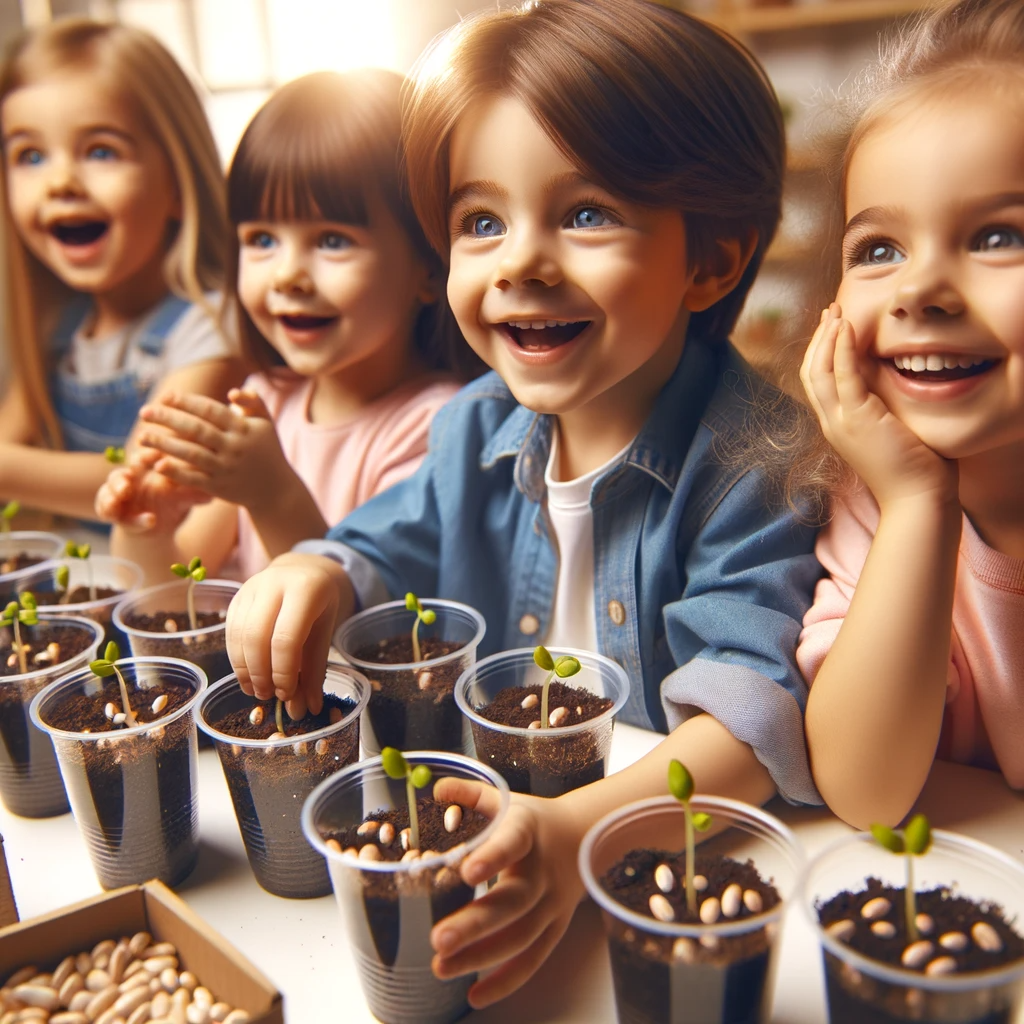
Fascinating Plant Facts
Sensitive Plant: Touch its leaves, and they'll fold up instantly!
Venus Flytrap: This plant eats insects by trapping them inside its leafy jaws.
Sunflowers: Their heads follow the sun, moving from east to west throughout the day.
Plants are incredible! They provide us with food, fresh air, and endless beauty. By understanding and appreciating plants, we can better care for our planet. So next time you see a flower or a tree, give it a little "thank you" for all it does!
Chapter 14: The Breath of Life: Why We Need Air
🍃💨
Every moment, even as you read this, you are doing something vital and magical: breathing. With each breath, you bring in the air that your body needs to stay alive. But why is air so important? Let's embark on a journey to understand the essence of the breath of life.
What is Air?
Air might seem like nothing because we can't see it, but it's a mixture of many different gases. The two most important ones for us are oxygen and carbon dioxide. About 21% of the air is oxygen, while a tiny part, around 0.04%, is carbon dioxide.
Oxygen: The Fuel for Our Cells
Oxygen is like fuel for our body. Every cell in our body needs it to produce energy. When we breathe in, our lungs take in oxygen, which then travels through our bloodstream and reaches every cell. The cells use this oxygen to burn the food we eat and produce energy in a process called respiration.
Breathing Out: The Role of Carbon Dioxide
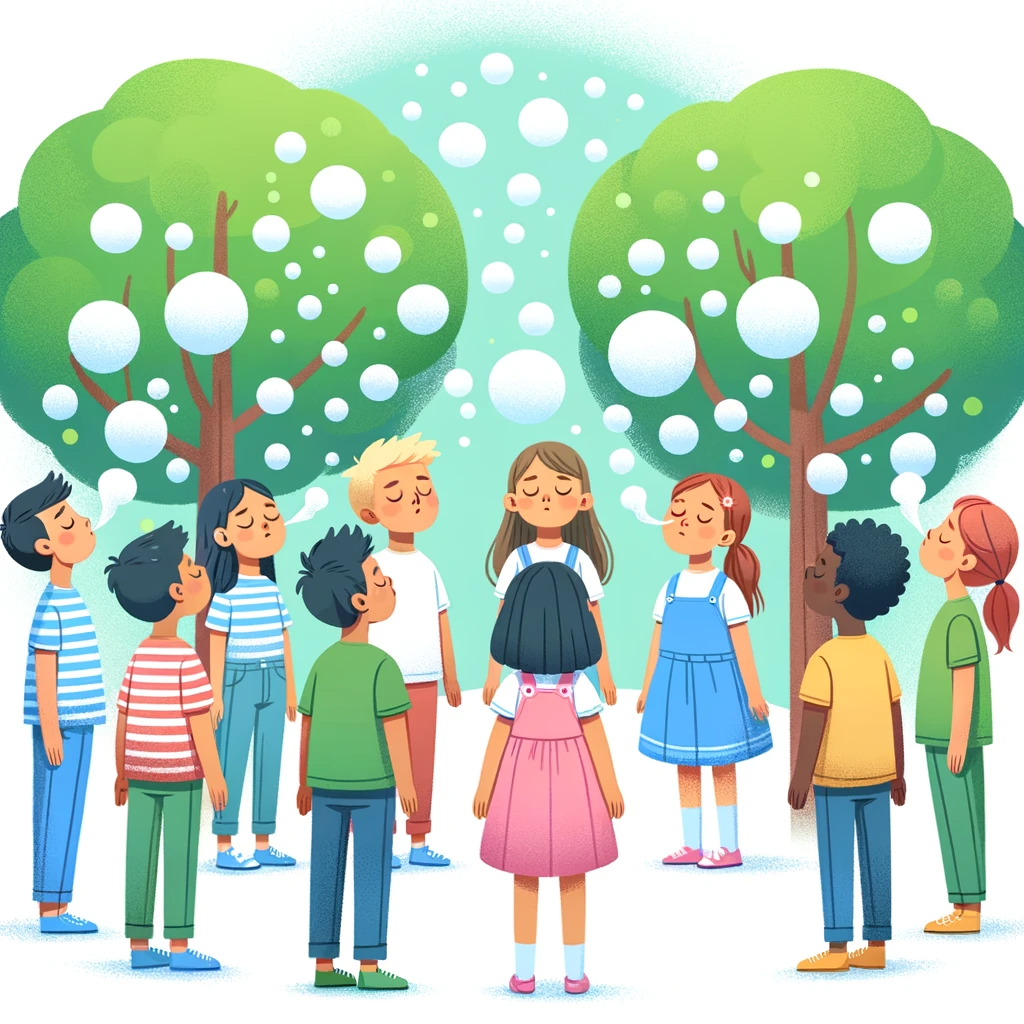
Just as we breathe in oxygen, we also breathe out carbon dioxide. But why? As our cells produce energy, they create carbon dioxide as a waste product. Our body needs to get rid of it, so we exhale it out. Plants, on the other hand, love carbon dioxide! They take it in and give out oxygen, which is why plants and humans are great partners in the cycle of life.
Air and Our Environment
Air doesn't just help us breathe; it plays a crucial role in our environment. Winds help spread seeds, allowing plants to grow in new places. Birds, insects, and many other creatures rely on the air to fly. Plus, air helps regulate the Earth's temperature, ensuring it's just right for life
Clean Air is Essential
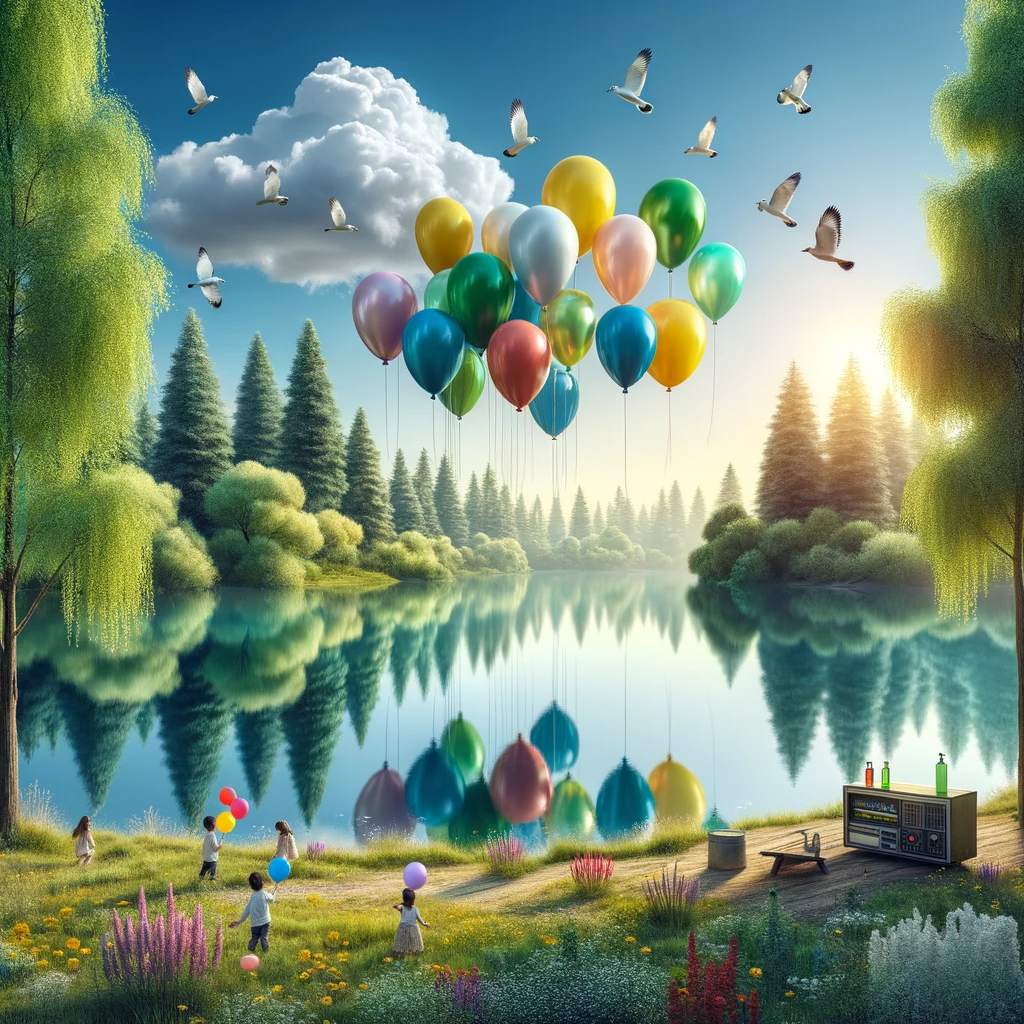
It's crucial for us to have clean air. Pollution, caused by factories, cars, and other sources, can make the air unhealthy to breathe. Polluted air can harm our lungs and the environment. That's why it's essential to take care of our planet by reducing pollution and planting more trees, which help clean the air.
Air is an invisible wonder that sustains life on Earth. Every breath we take connects us to the world around us, reminding us of the delicate balance of life. So, the next time you take a deep breath, think about the marvelous science that keeps you alive and the world spinning.
🍃 Cherish the air and our beautiful planet! 🌍
Chapter 15: Machines and Us: Simple Machines that Make Life Easier
🔧🔩
From the moment we wake up to the time we go to bed, machines play a crucial role in our lives. But did you know that many of the complex machines we see around us are based on simple principles? Let's dive into the world of simple machines and discover how they make our lives so much easier!
What is a Simple Machine?
A simple machine is a device that changes the direction or magnitude of a force. In other words, they help us do work with less effort. There are six primary simple machines: the lever, wheel and axle, pulley, inclined plane, screw, and wedge.
1. The Lever: Lift and Balance
Imagine trying to lift a heavy rock. It would be challenging, right? But place a long stick under the rock with a support in the middle, and voila! You have a lever. By pressing down on one end of the stick, you can easily lift the rock on the other end. Seesaws in playgrounds are perfect examples of levers.
2. Wheel and Axle: Rolling Along
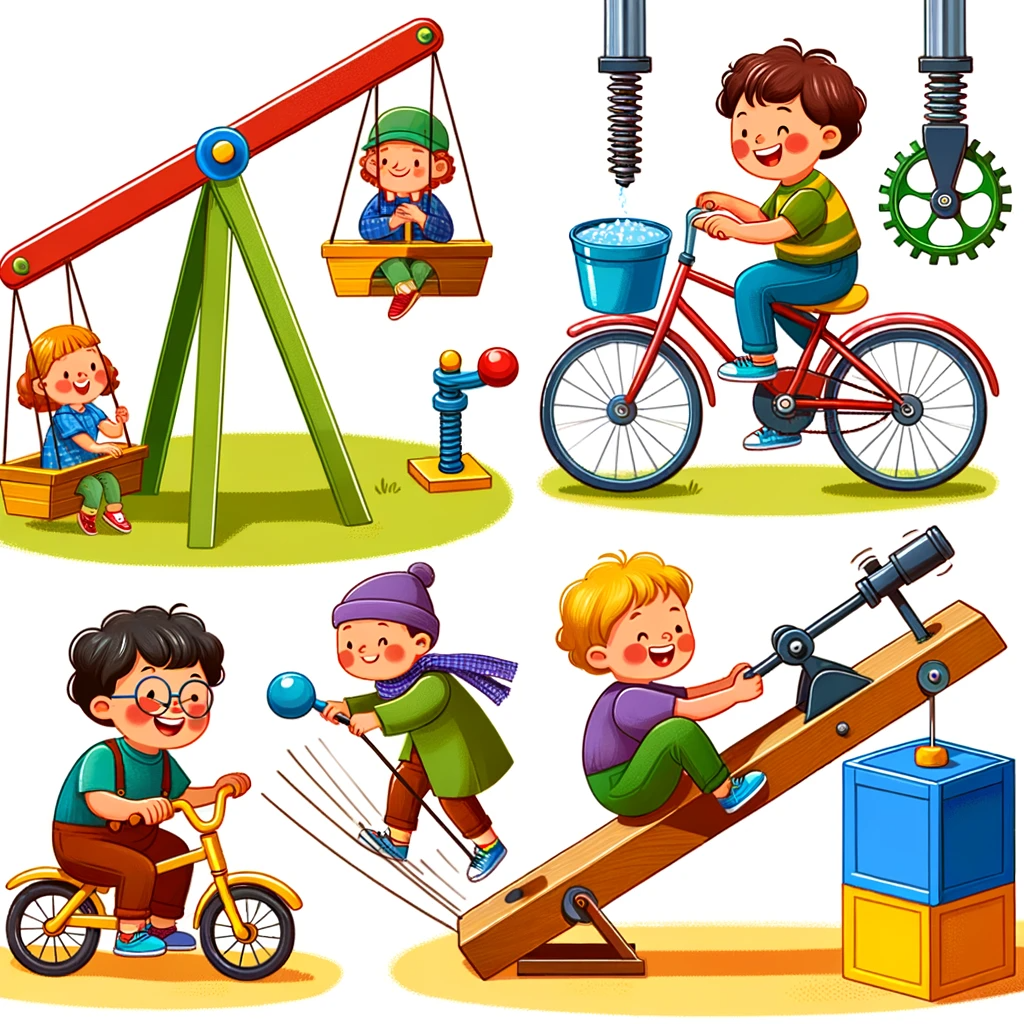
The wheel and axle make moving things easier. When you ride a bike or a scooter, the wheels help you go faster with less effort. The axle, the rod in the center, supports the wheel and helps it turn smoothly./p>
3. Pulley: Lifting Made Easy
A pulley is a wheel with a rope or belt around it. By pulling on one end of the rope, you can lift heavy objects with ease. Elevators and blinds use pulleys to function.
4. Inclined Plane: Sliding Up and Down
An inclined plane is a flat surface that is tilted. Instead of lifting a heavy box straight up, you can slide it up an inclined plane, like a ramp, which requires less effort.
5. Screw: Holding Things Together
A screw is like an inclined plane wrapped around a cylinder. It helps hold things together or lift objects. Think of a jar lid or a light bulb; turning them uses the principle of the screw.
6. Wedge: Splitting and Cutting
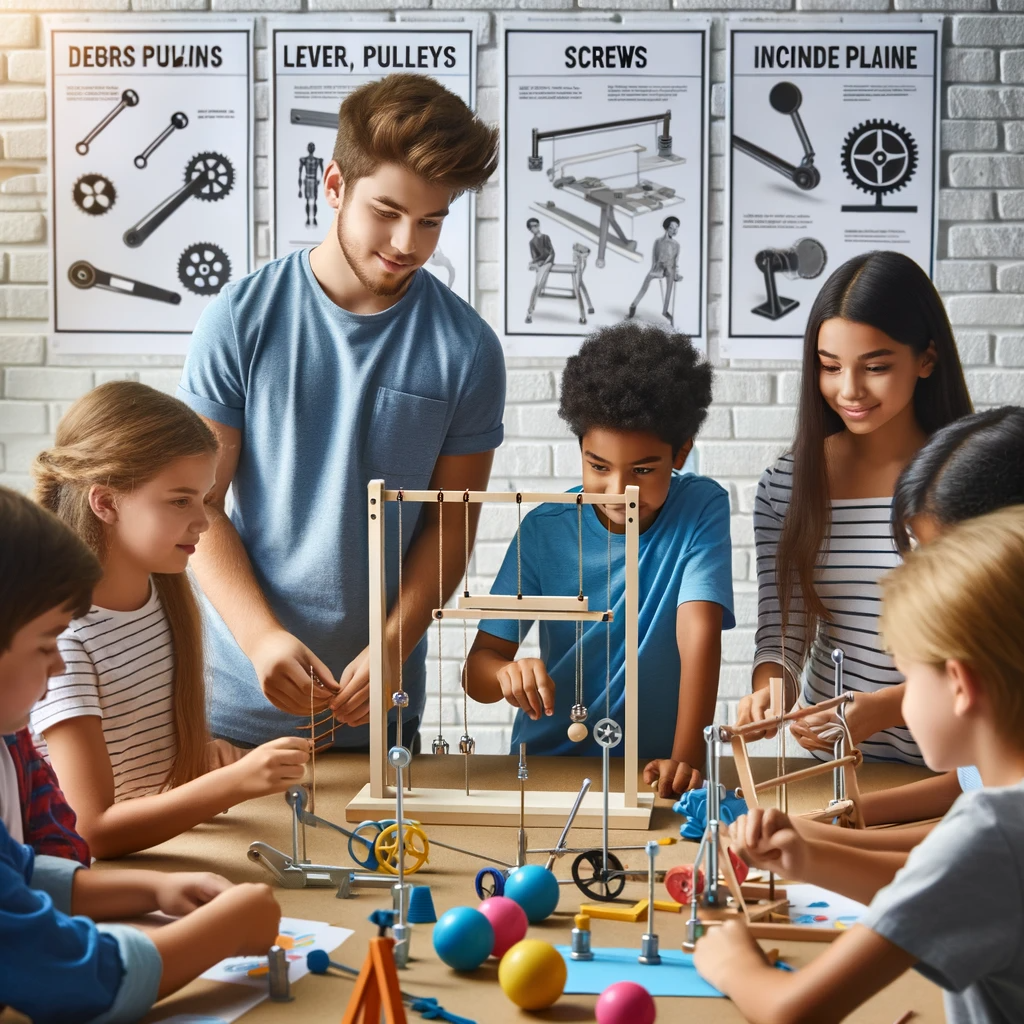
A wedge is like two inclined planes back to back. It's used to split, cut, or hold objects in place. Knives, axes, and doorstops are all examples of wedges.
Simple machines are everywhere! They are the foundation of many complex machines and tools we use daily. By understanding how they work, we can appreciate the science and engineering behind the devices that make our lives more comfortable and efficient. 🔧 So, the next time you use a tool or a machine, take a moment to think about the simple machines that make it work. The world of machines is fascinating, and it's all around us! 🛠️
Chapter 16: The Digital Playground: Computers and How They Think
💻🖥️
Once upon a time, people used to imagine a future where machines could think and solve problems like humans. Guess what? That future is now! Welcome to the digital playground, where we'll explore the magic of computers and how they "think."
The Brain of the Computer
Just like our brains are the control centers of our bodies, the computer has a brain too! It's called the Central Processing Unit (CPU). This tiny chip processes all the information and makes sure everything runs smoothly.

Ones and Zeros: The Language of Computers
We speak in words, but computers have their language made of just two numbers: 1 and 0. This system is called binary code. Every picture you see, every song you hear, and every game you play on the computer is, at its core, a combination of ones and zeros!
Memory Matters
Have you ever wondered how computers remember things? They have something called memory. There's the RAM (Random Access Memory), which is like our short-term memory. And then there's the hard drive or SSD, which is like our long-term memory where all the data is stored.
Software: Telling the Computer What to Do
While the hardware is the physical part of the computer, software is the set of instructions that tells the computer what to do. From your favorite video games to the web browser you use, it's all software.
The Magic of Algorithms
An algorithm is a set of instructions to solve a problem. Just like when we follow a recipe to bake a cake, computers use algorithms to carry out tasks. Every time you search for something online, algorithms help find the best results for you.
Internet: The Global Playground

The internet connects computers from all around the world. Imagine a giant web where every computer is a point on that web. It allows us to play games with friends from different countries, learn new things, and even watch funny cat videos
Safety First!
Just like in a real playground, it's essential to be safe in the digital playground. Always remember not to share personal information online and be cautious about the websites you visit.
Computers are incredible tools that have transformed our world. They might seem complex, but at their heart, they follow simple principles. By understanding how they work, we can become better digital explorers and make the most of this fantastic digital playground.
💾 So, dive in, explore, and remember: the digital world is full of wonders waiting for you to discover! 🌐
Conclusion: Your Journey as a Young Scientist
🔭🌌🔬
As we come to the end of this book, it's important to remember that every page you turned, every experiment you pondered, and every question you asked is a step in your journey as a young scientist. Science is not just about facts and figures; it's about curiosity, wonder, and the thrill of discovery.
Throughout this book, we've dived deep into various scientific wonders, from the tiniest atoms to the vastness of the universe. We've learned that questions are the heart of science, and there's no such thing as a silly question. The most groundbreaking scientific discoveries often started with a simple, "I wonder why..."
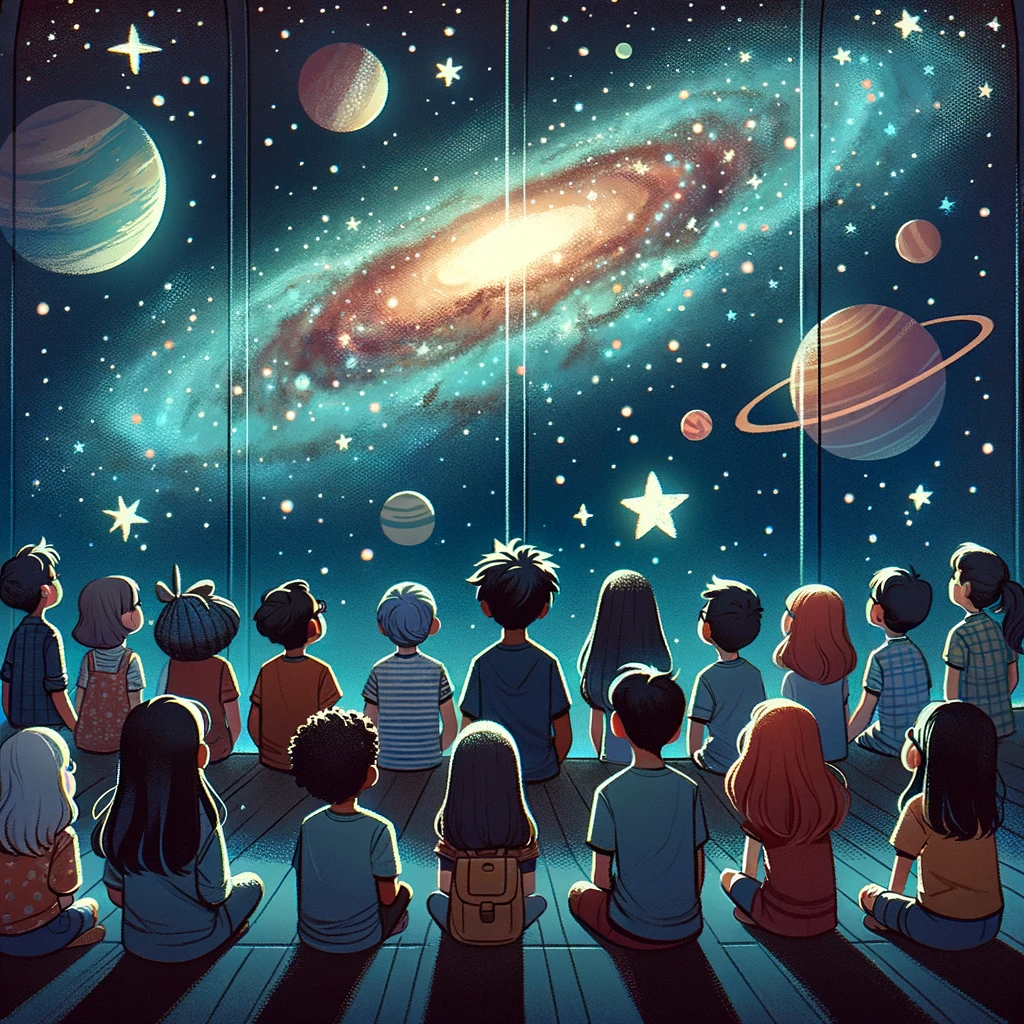
As you move forward, always carry the spirit of exploration with you. The world is full of mysteries waiting to be uncovered, and you have the tools to explore, understand, and make a difference. Remember that every great scientist, from Marie Curie to Albert Einstein, was once a curious child just like you.
Don't stop here. Visit libraries, explore nature, conduct your own experiments, and never stop asking questions. The world is your laboratory, and there's so much more to discover. You might even come up with a theory or invention that changes the world
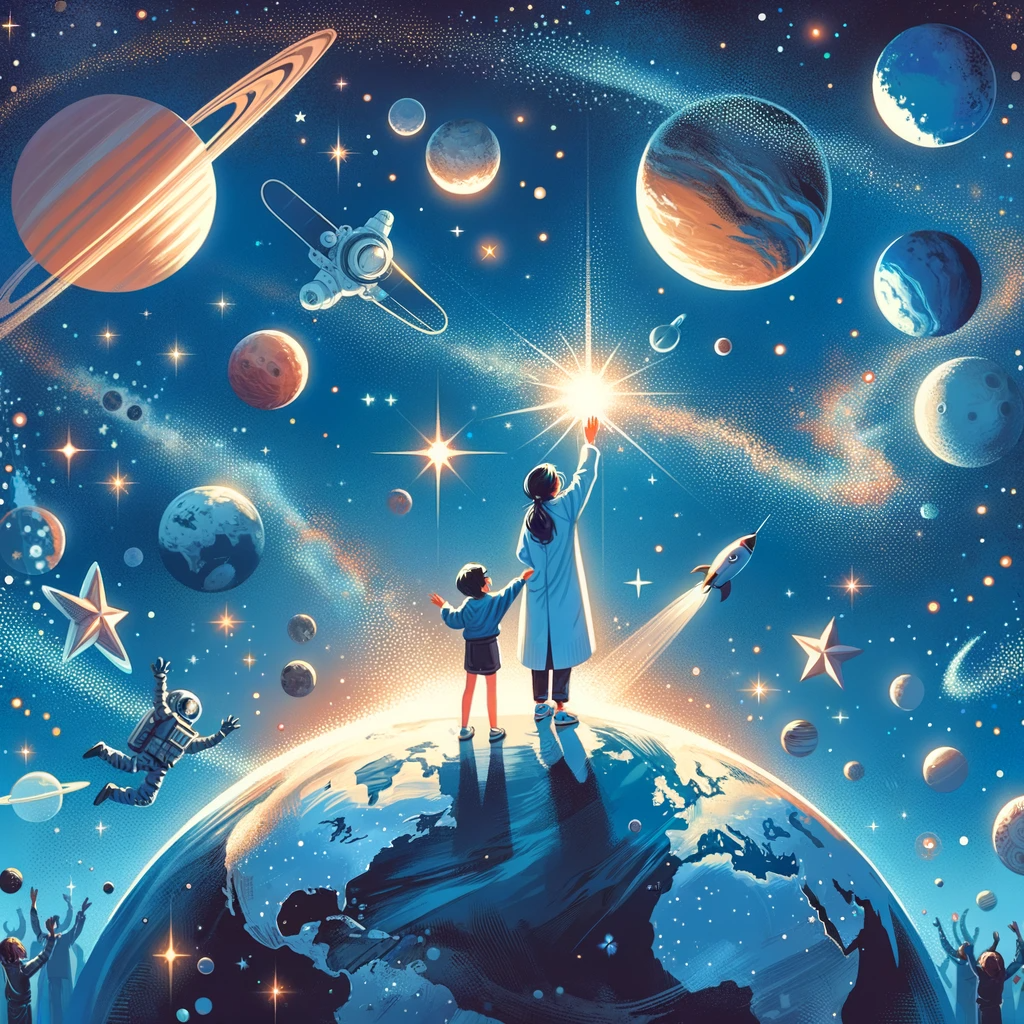
Lastly, always share your findings and excitement with others. Science is a collaborative effort, and together, we can unravel the secrets of the universe. Whether you choose a career in science or simply remain a curious soul, always cherish the beauty and wonder of the world around you.
Thank you for embarking on this scientific adventure with us. Your journey as a young scientist has just begun, and the sky is not the limit—it's just the beginning!
🚀 Safe travels on your journey of discovery, young scientist! 🌟

By Tommy Hong
About ME:

Venmo